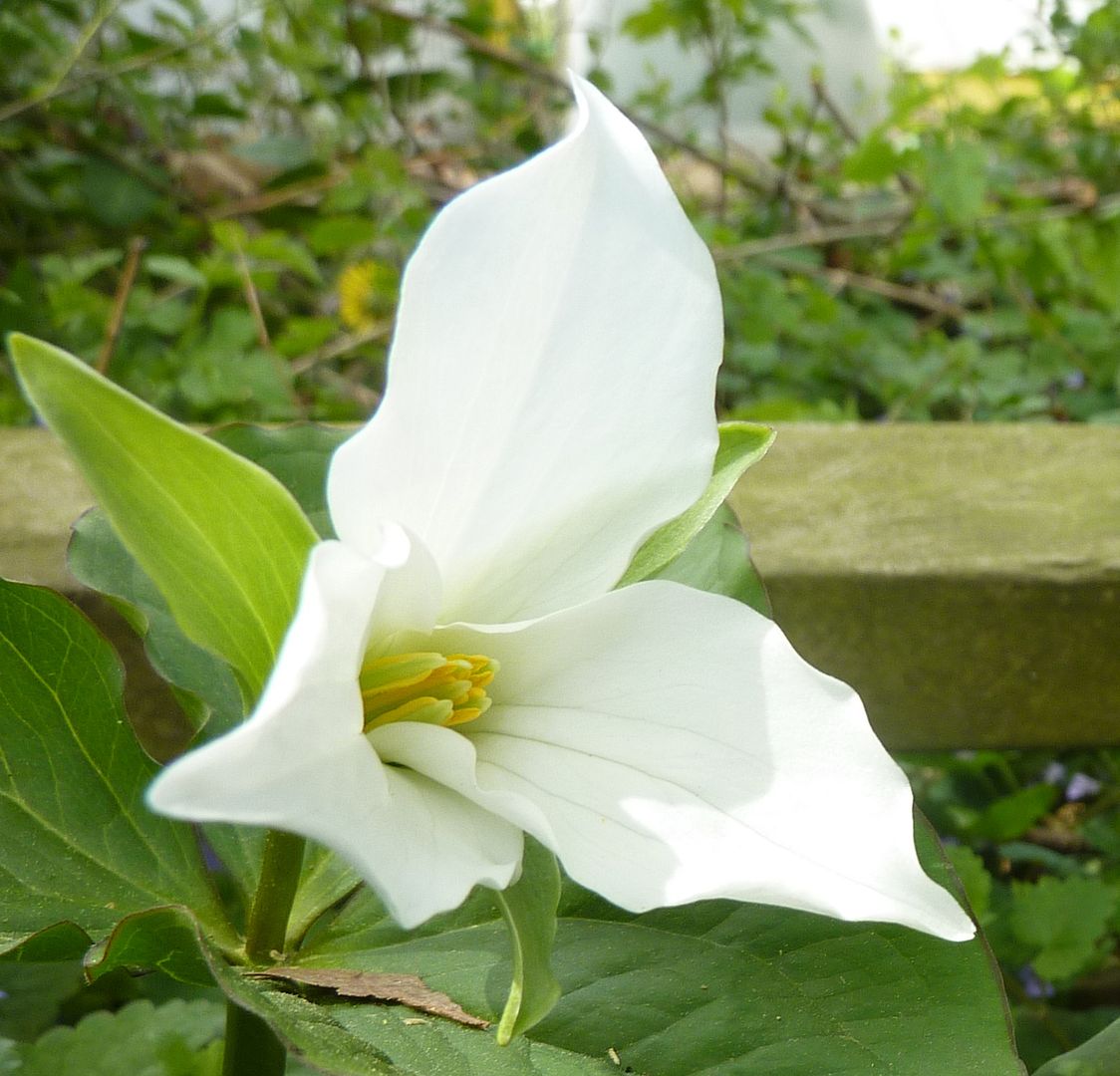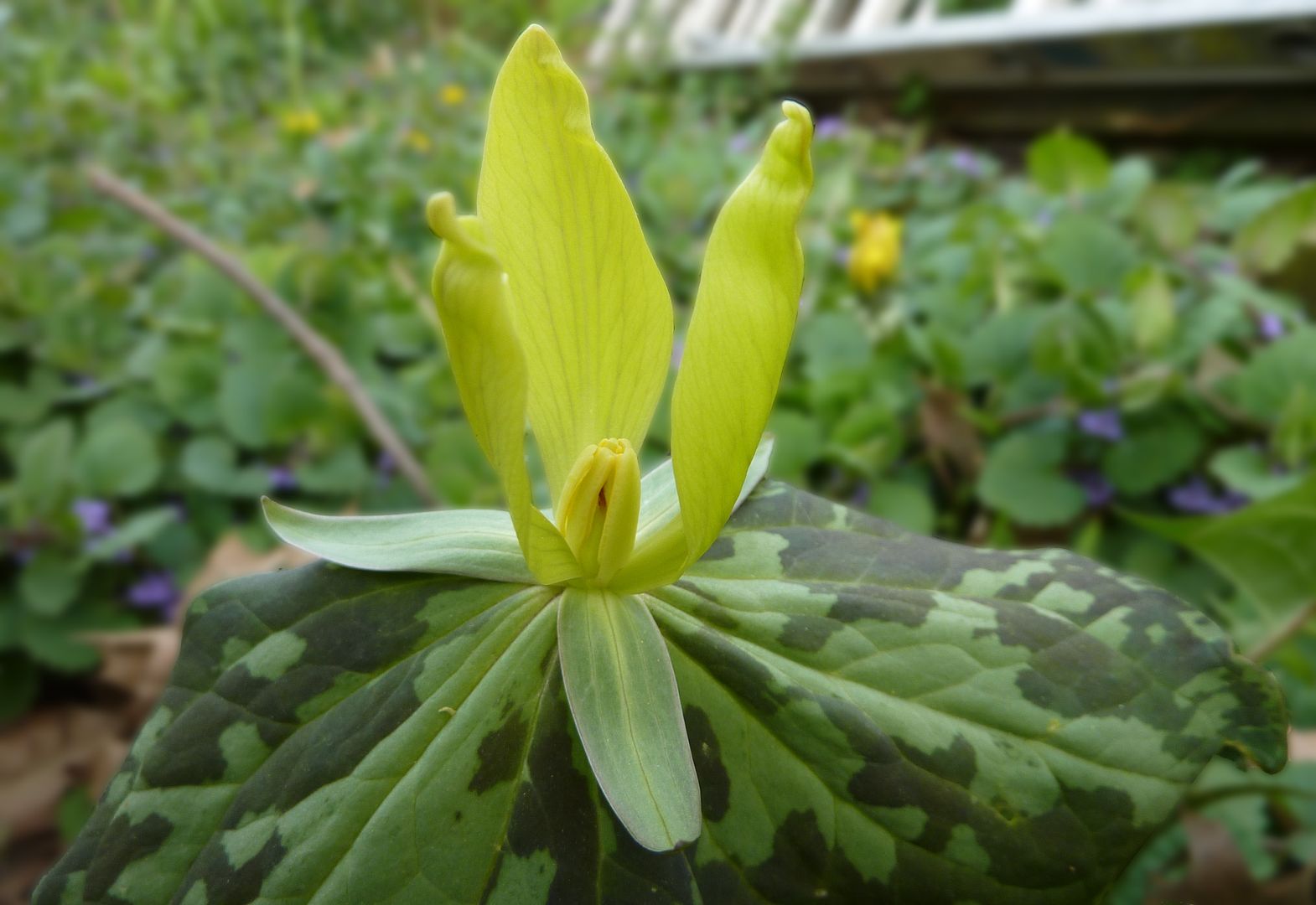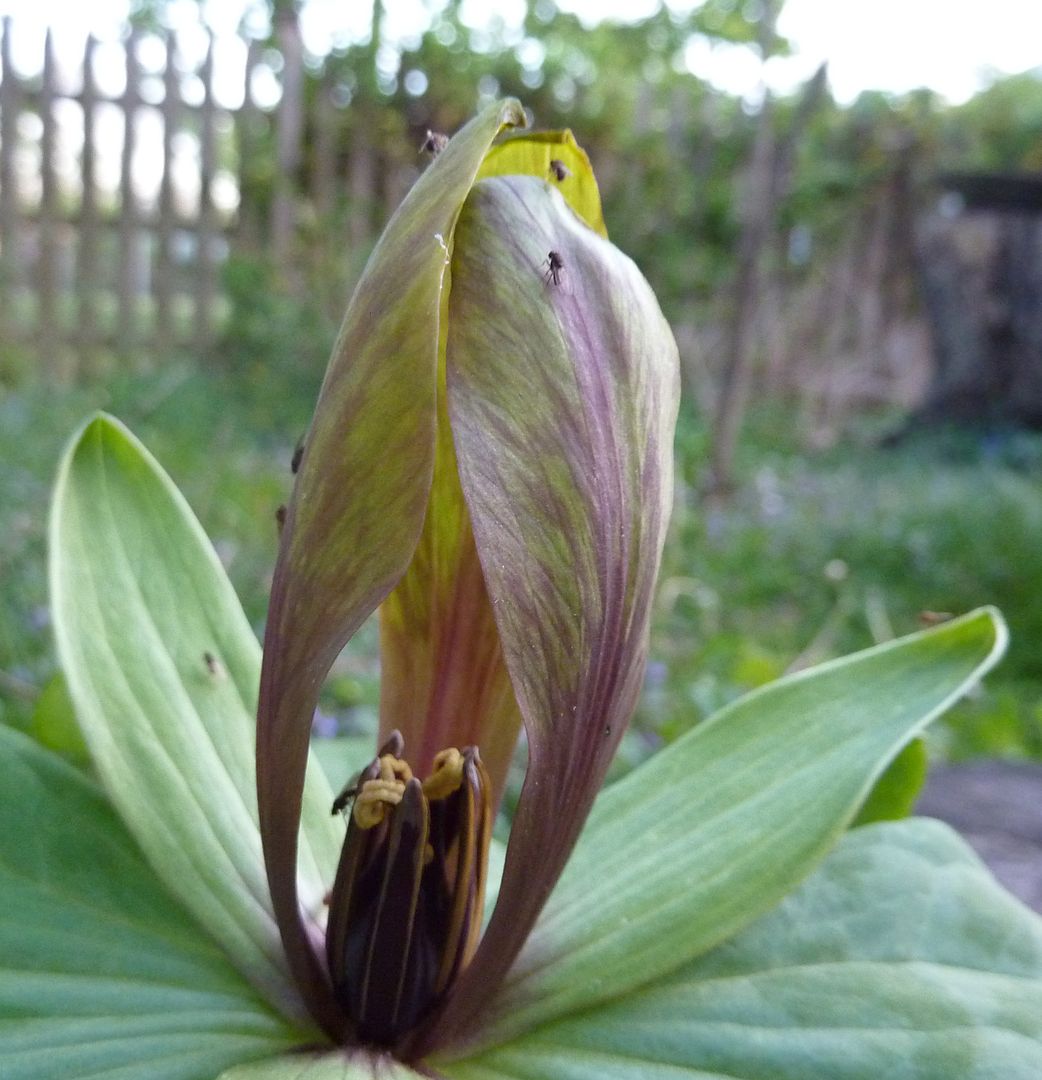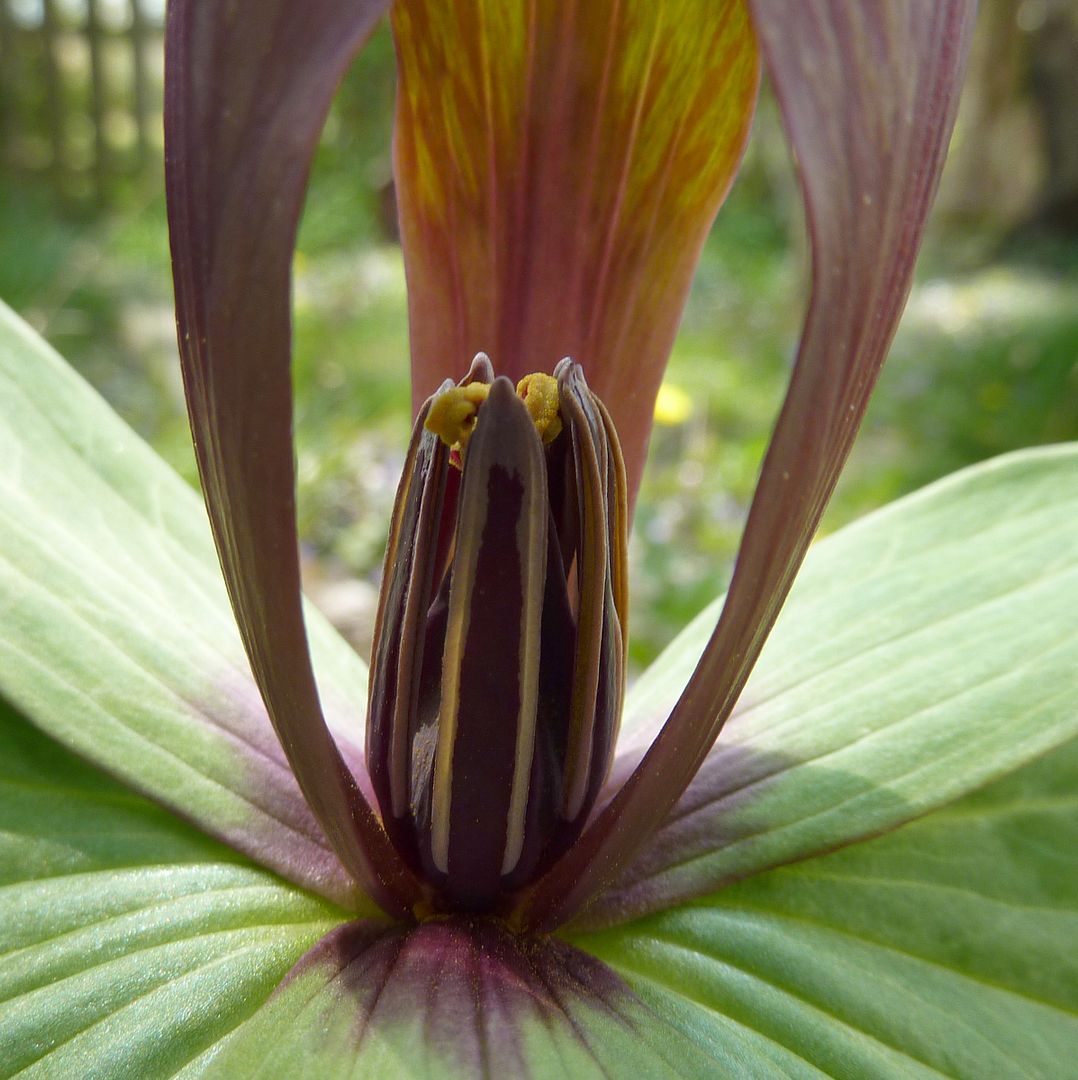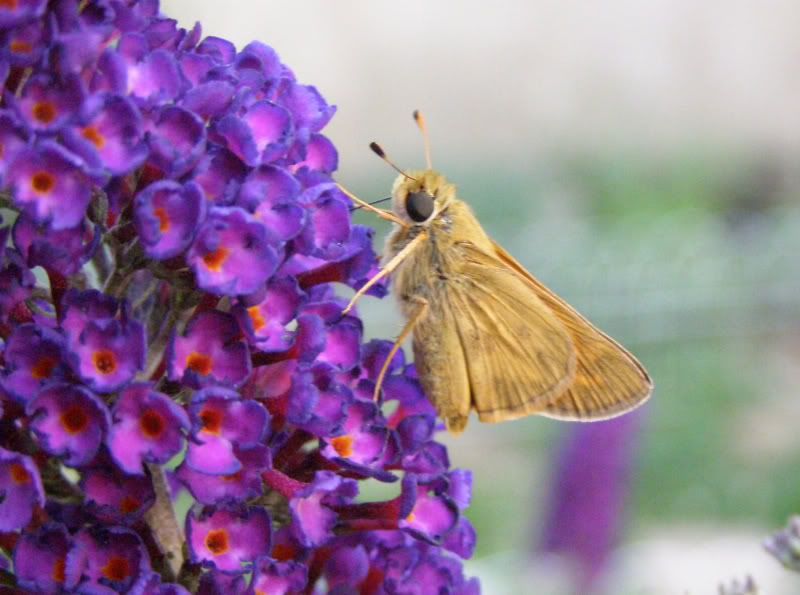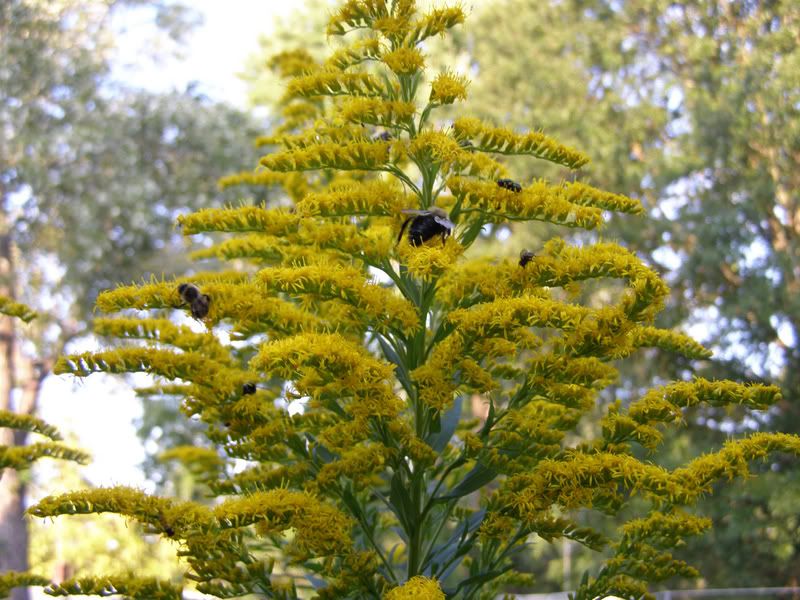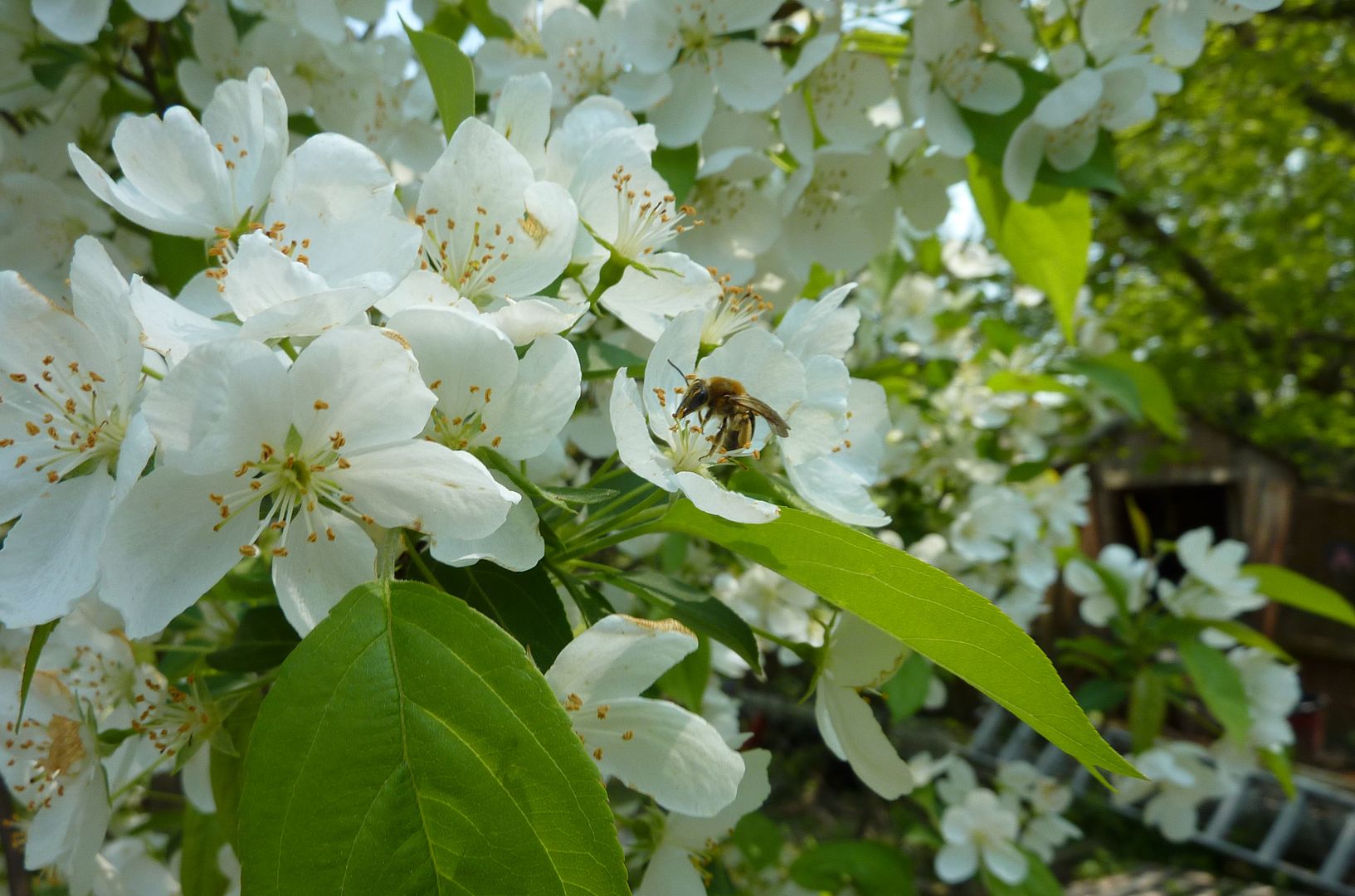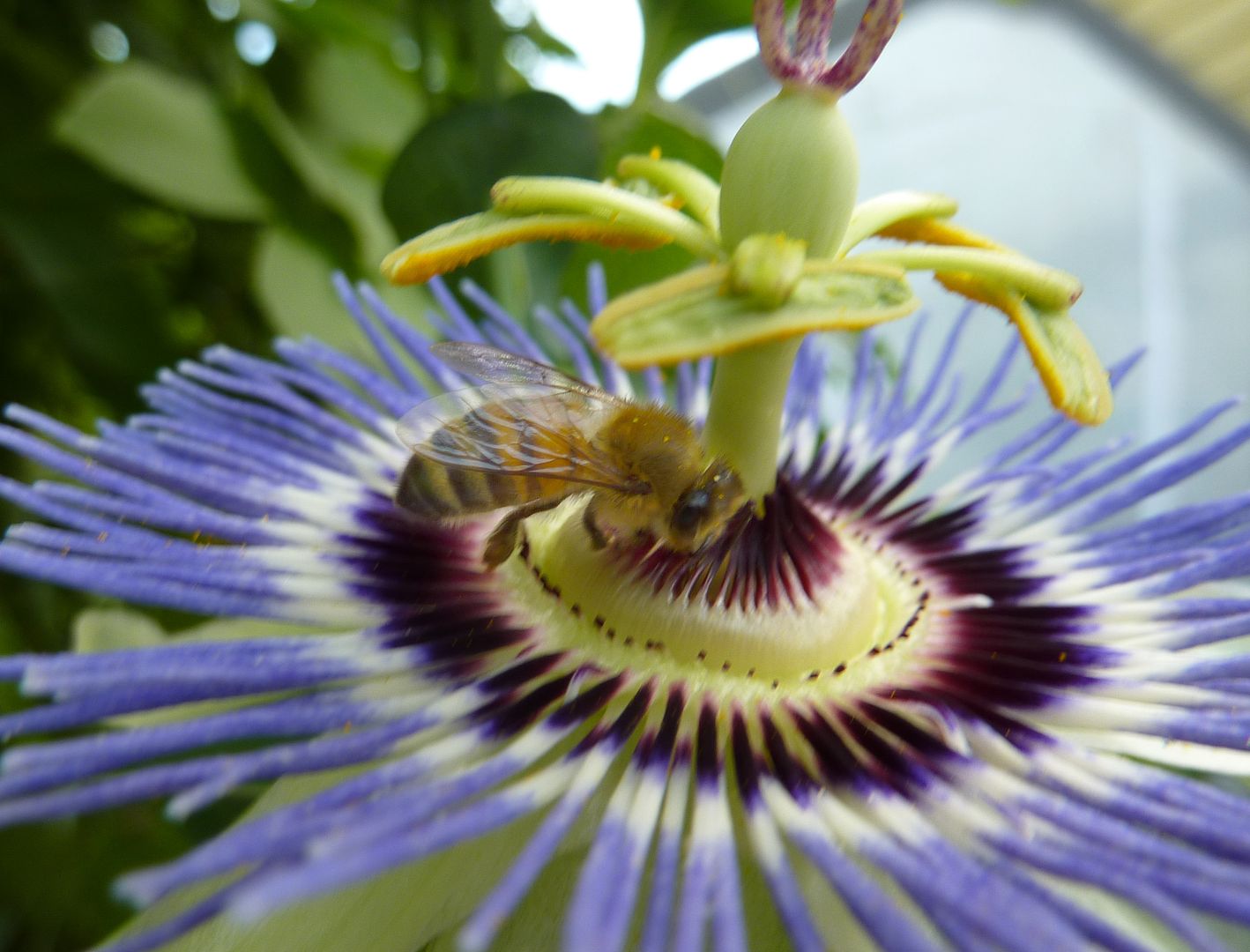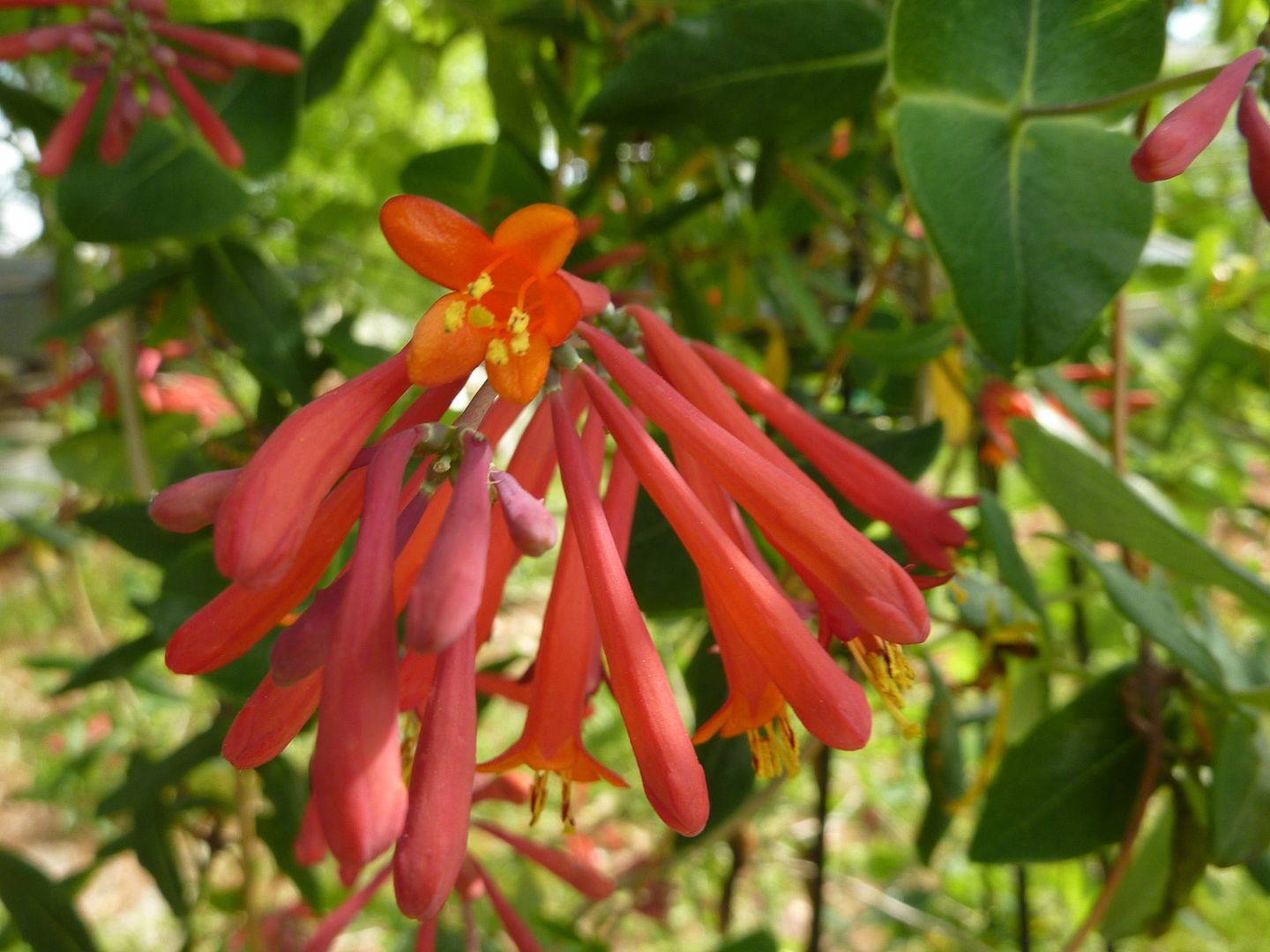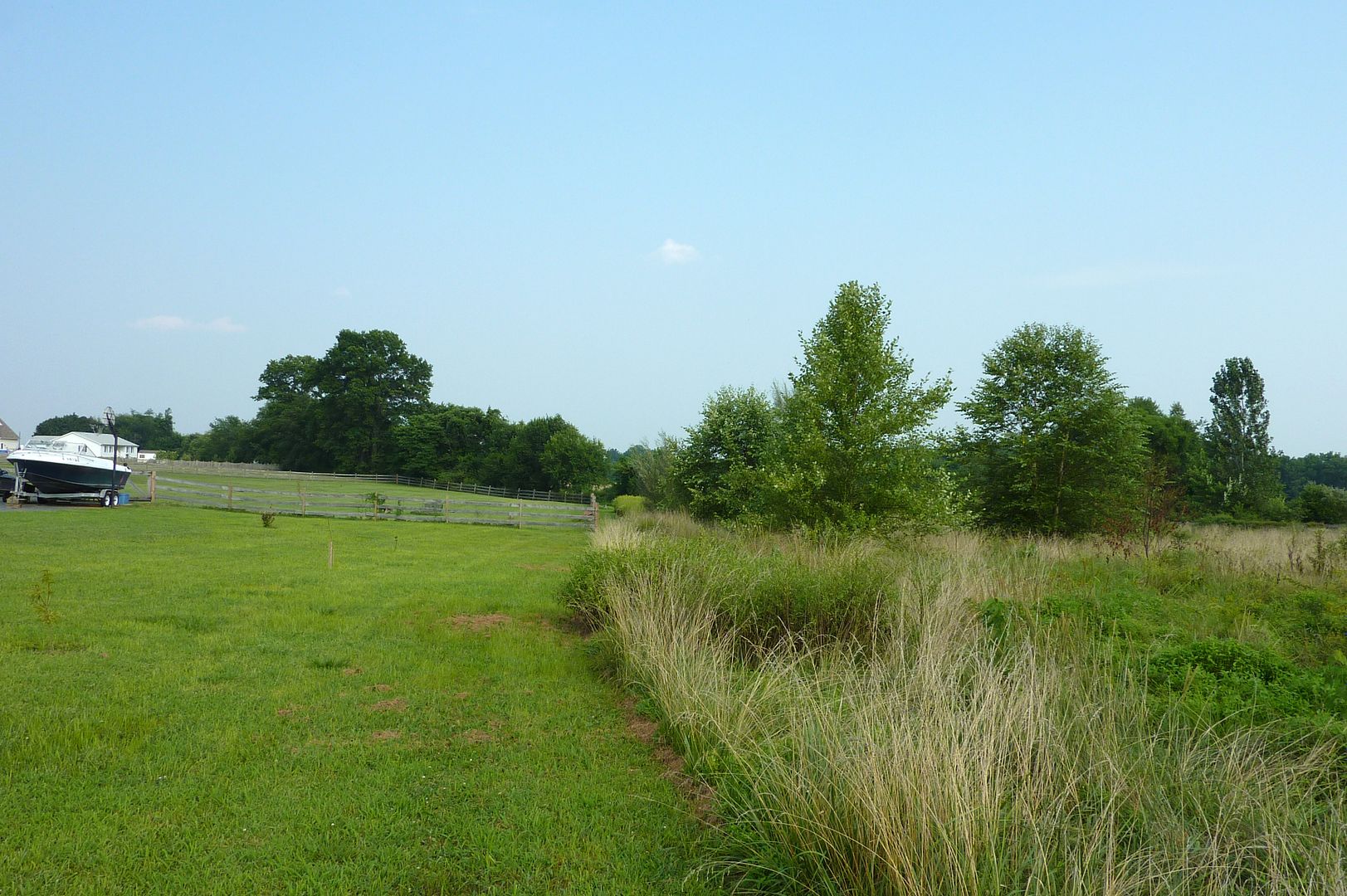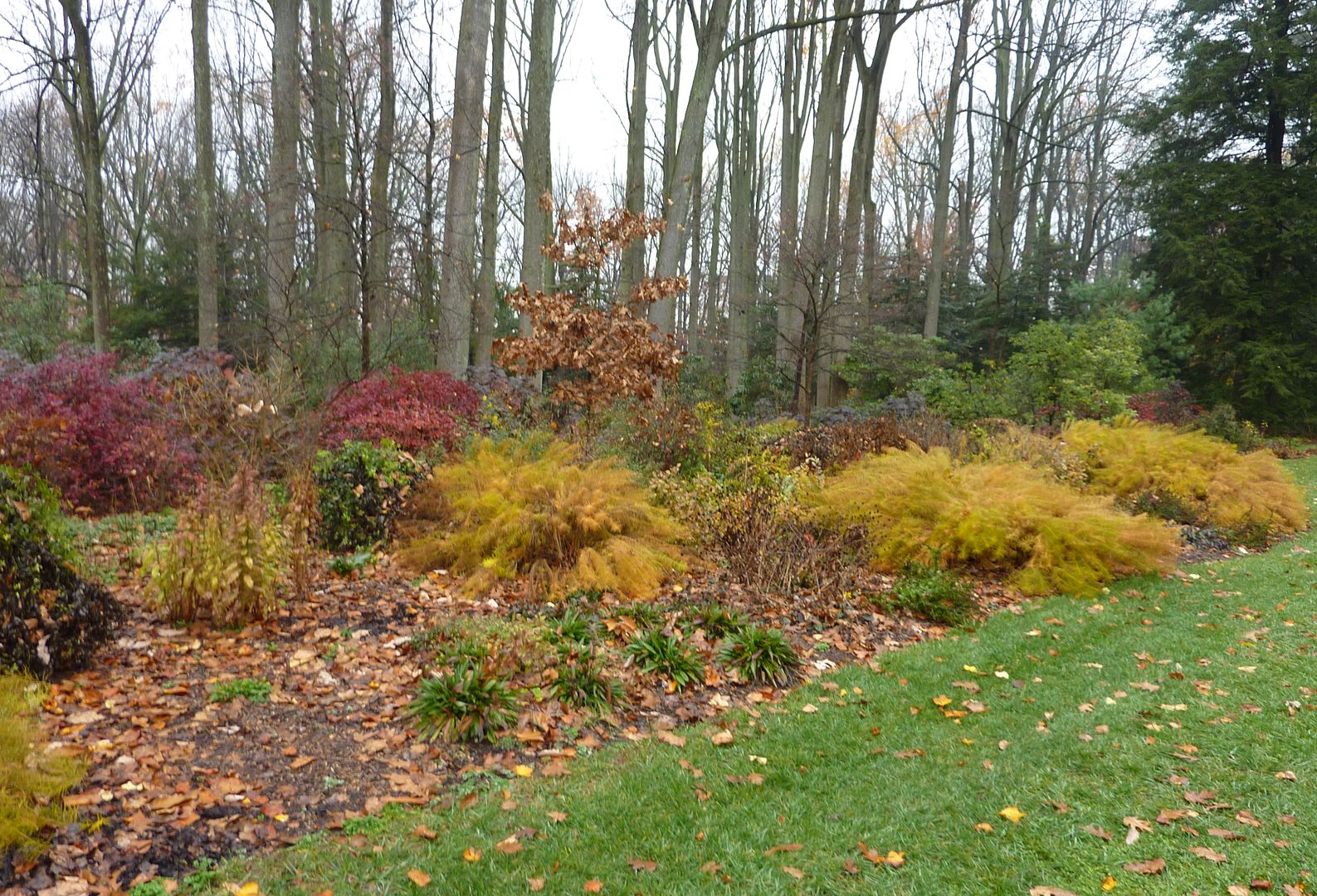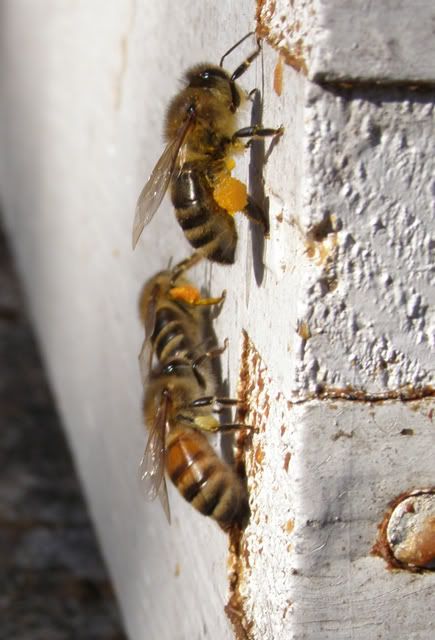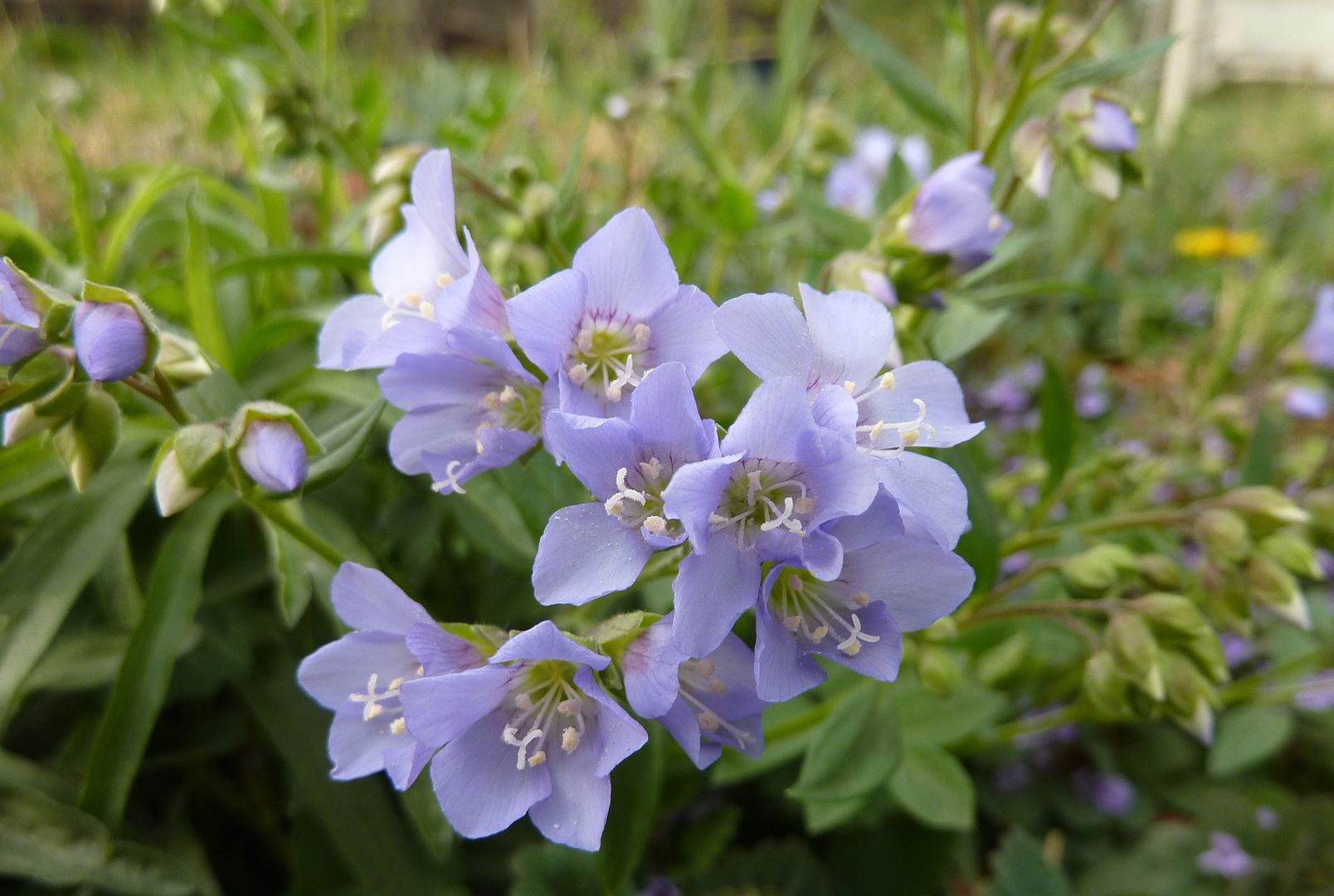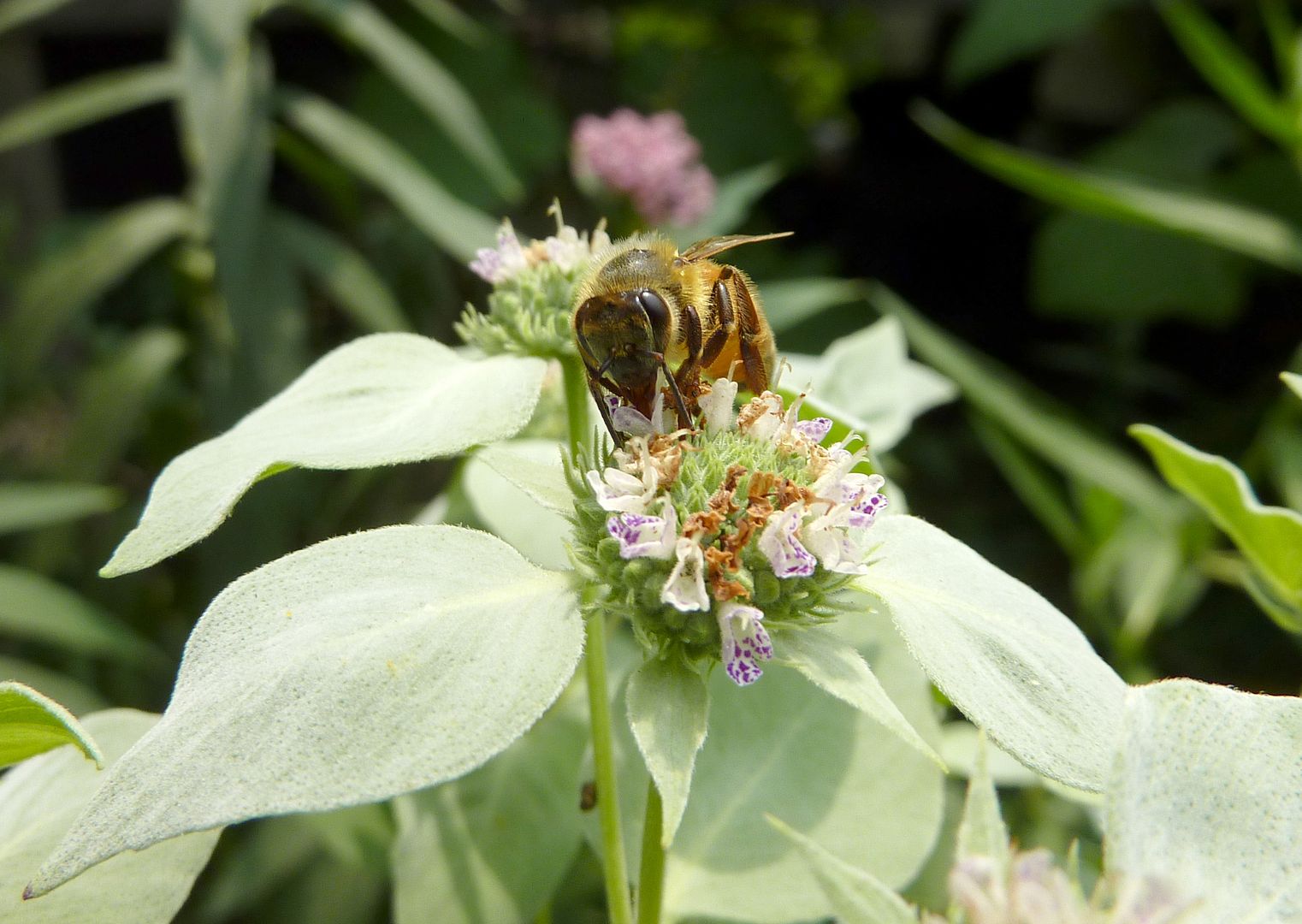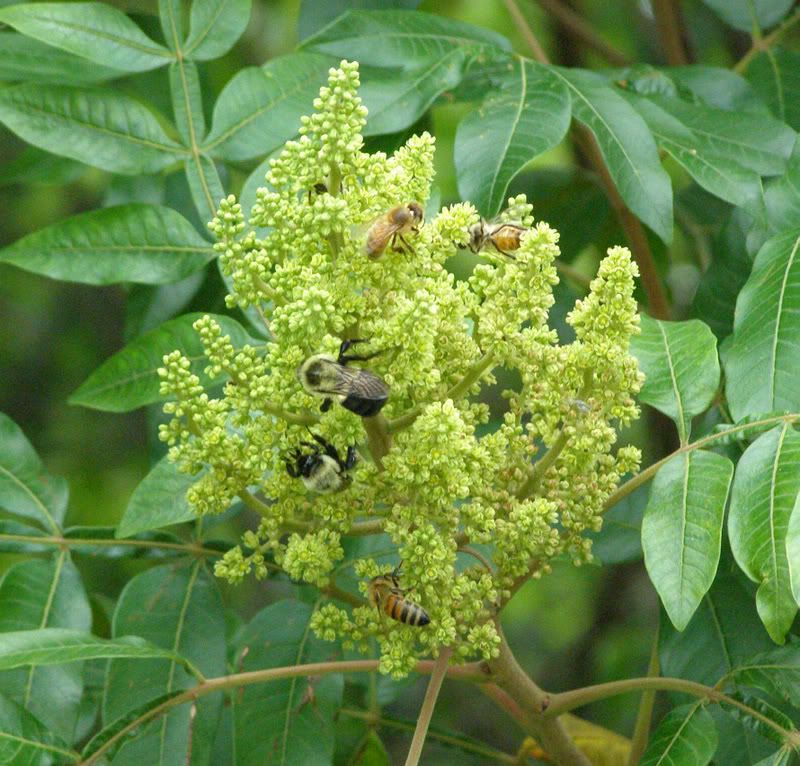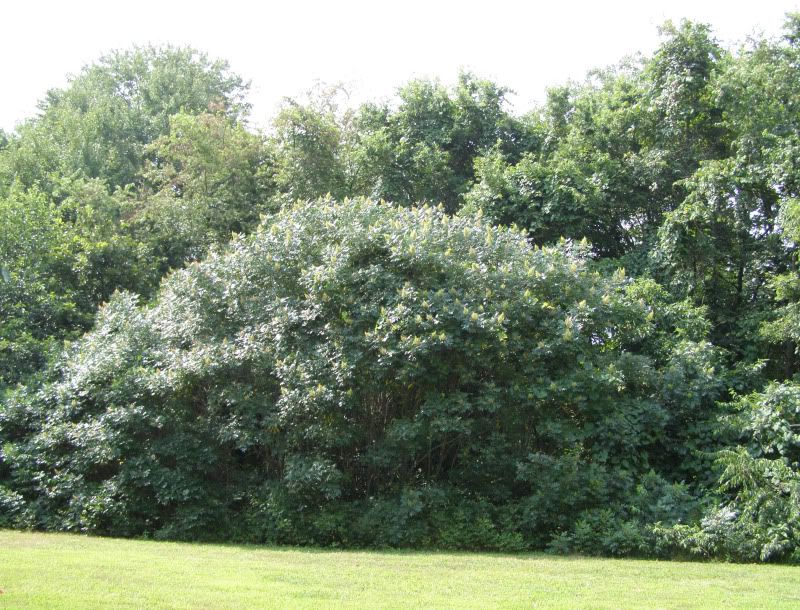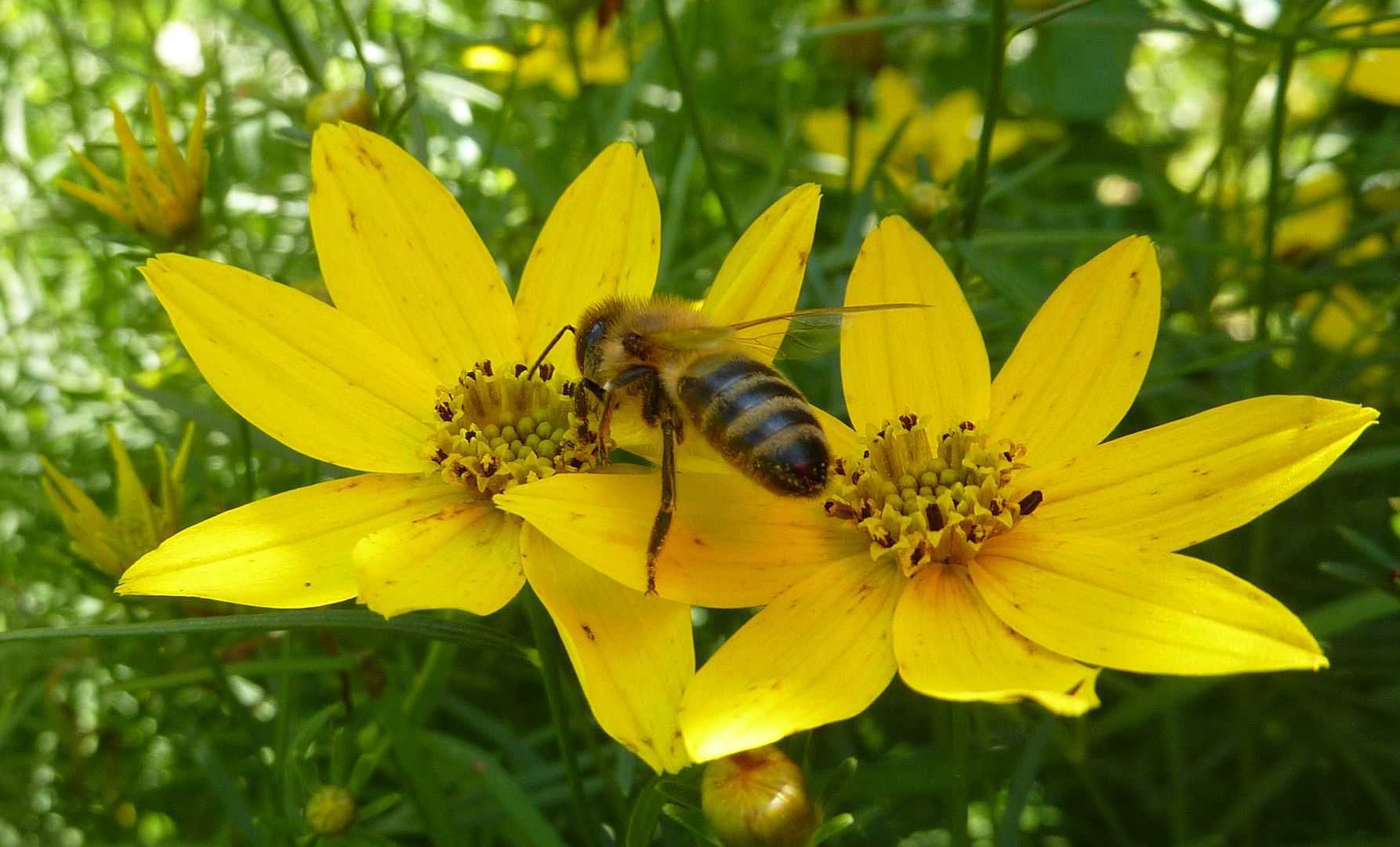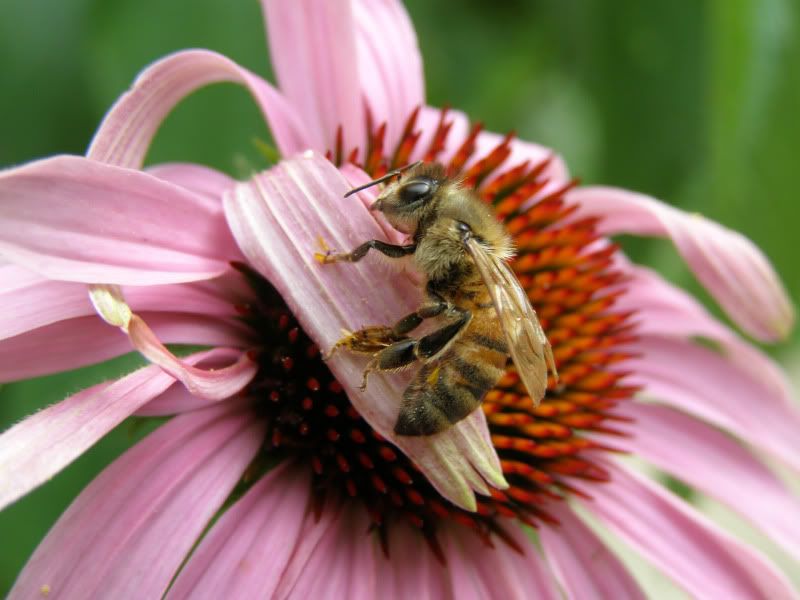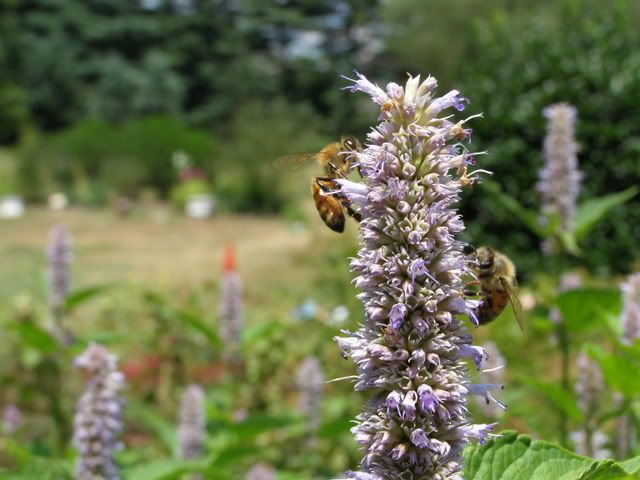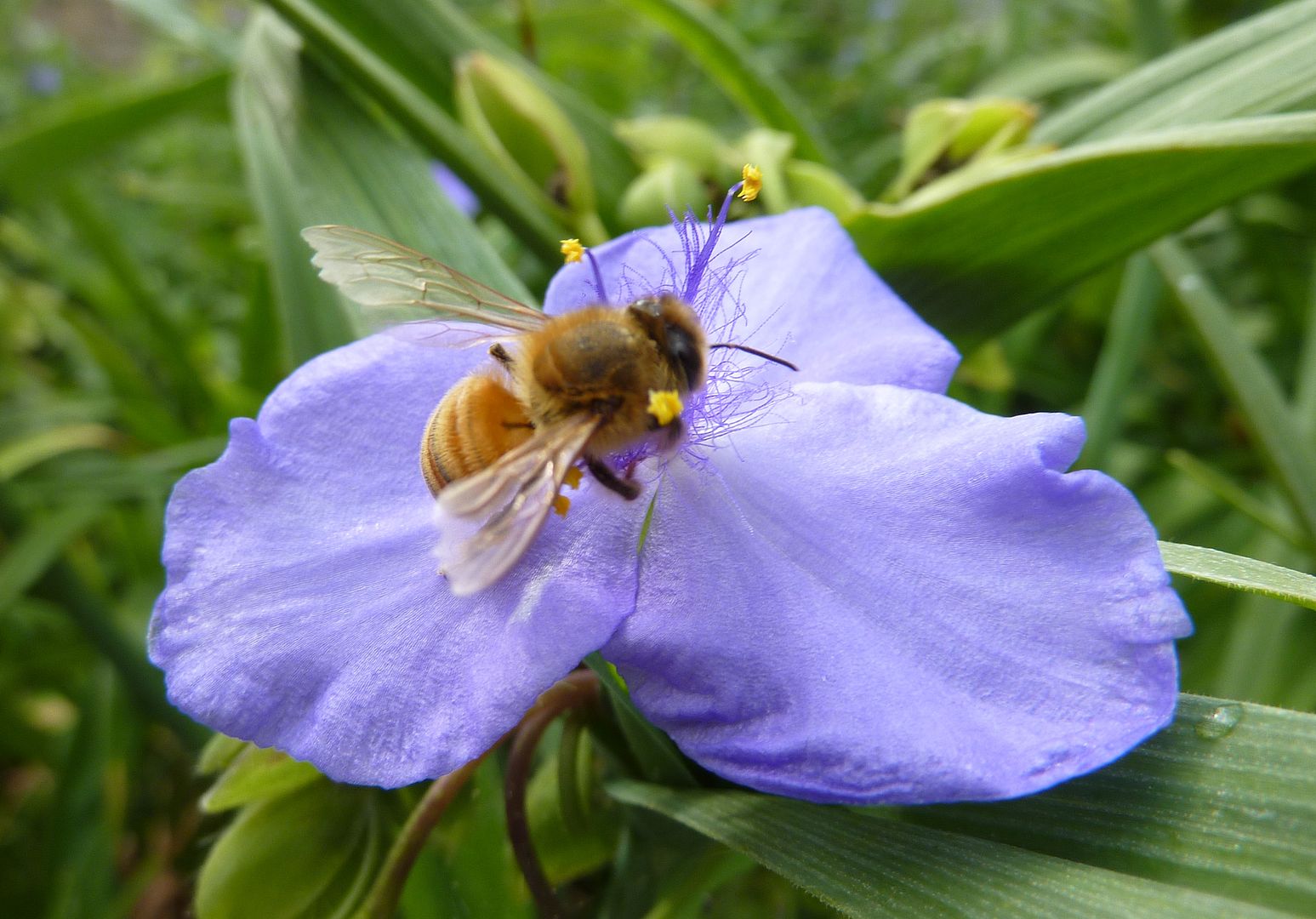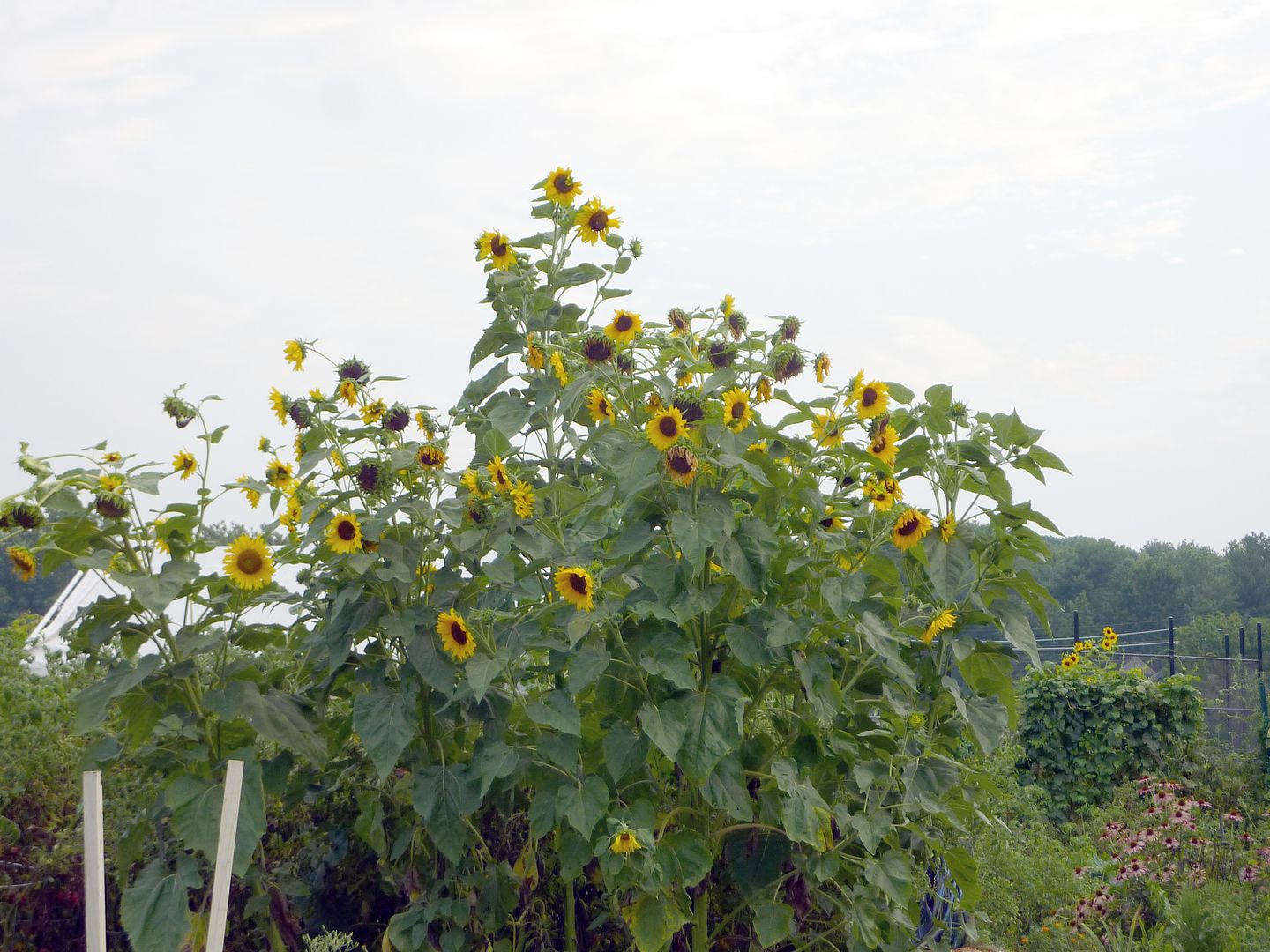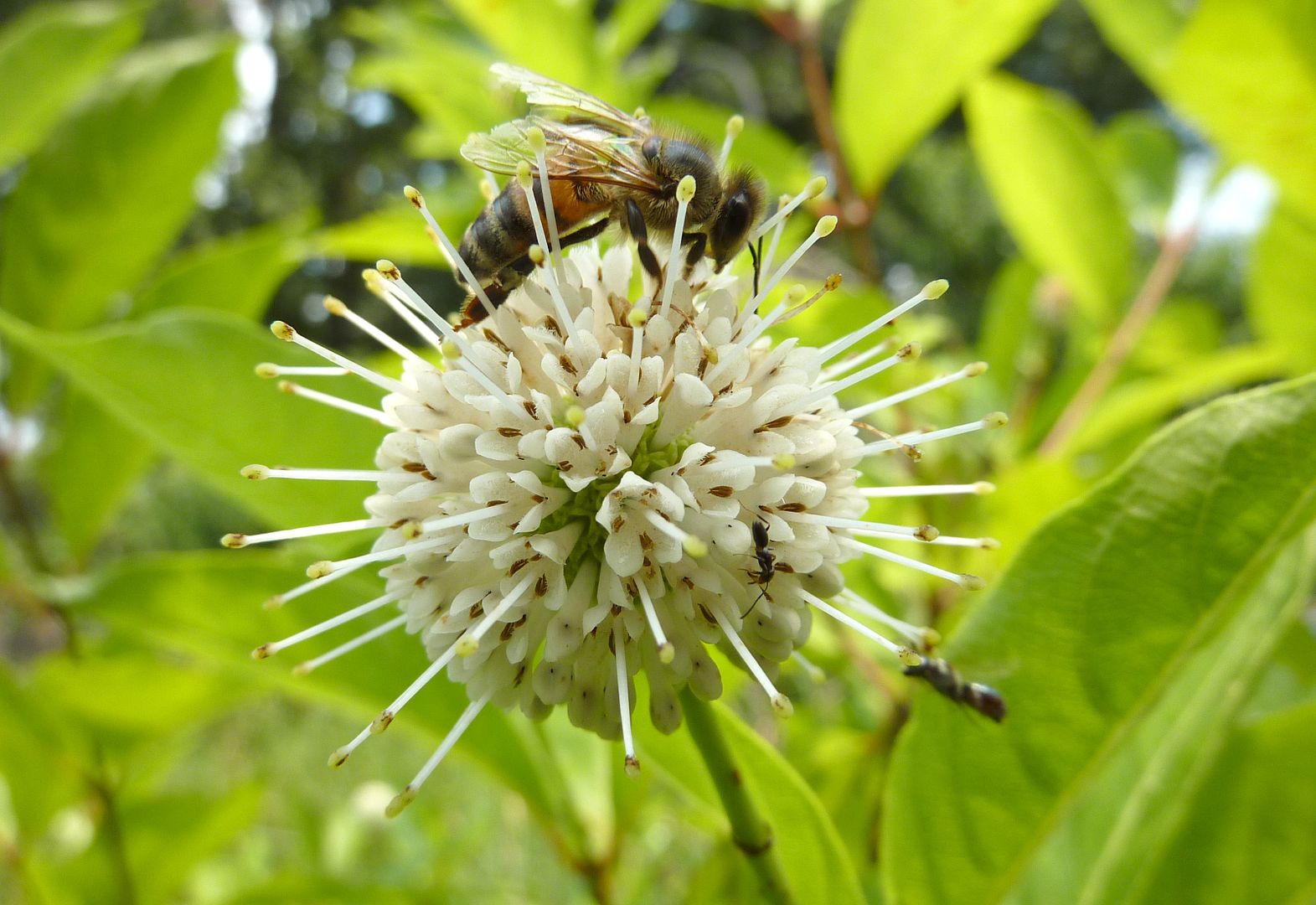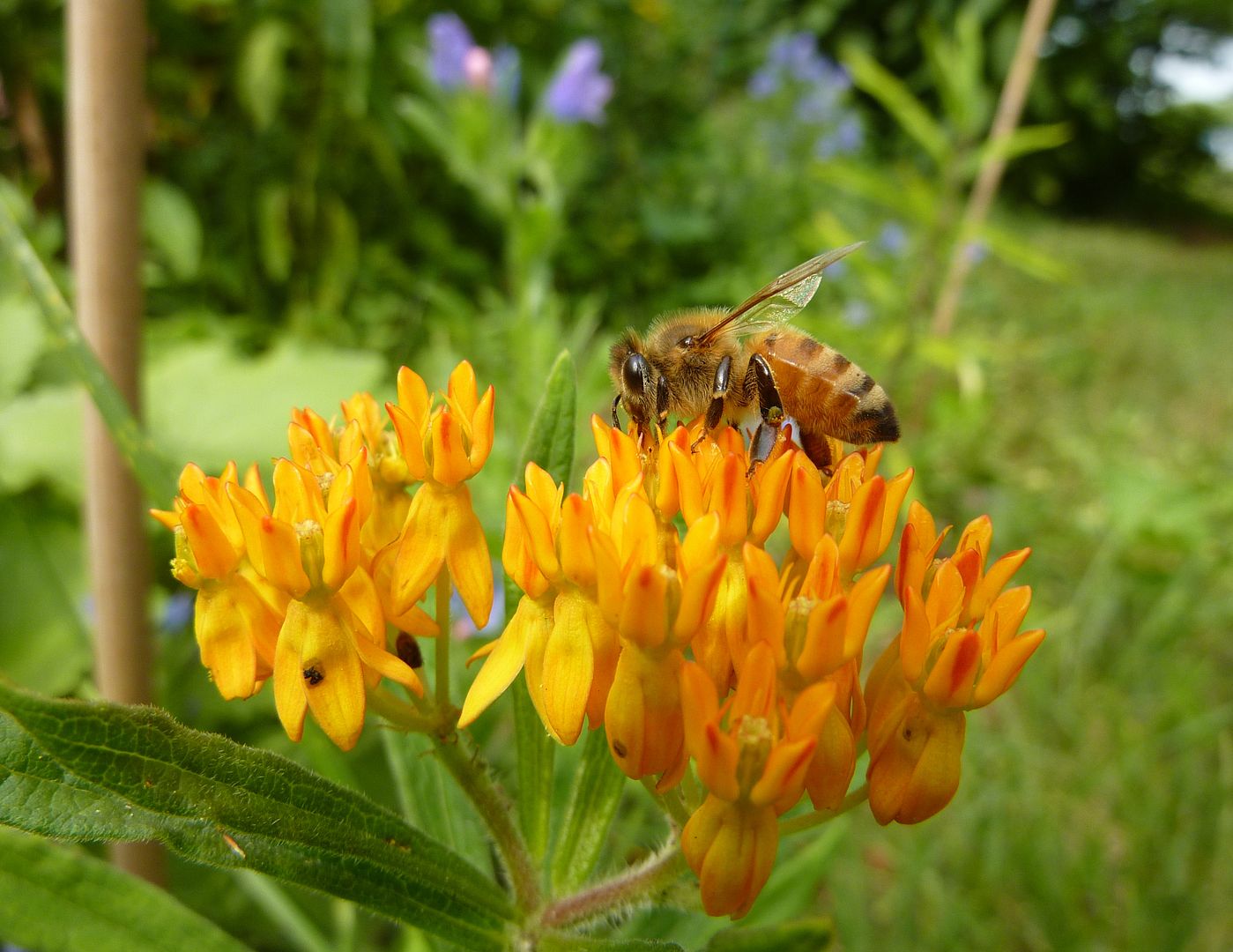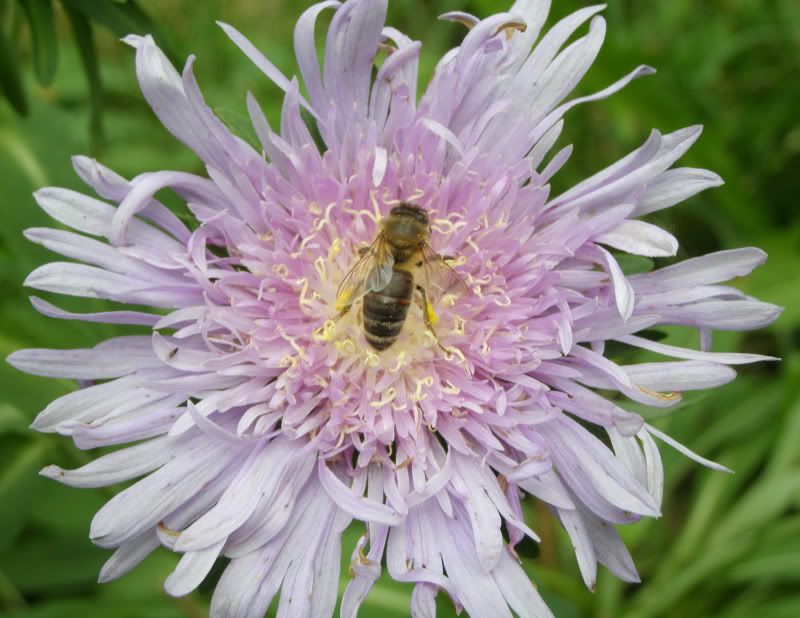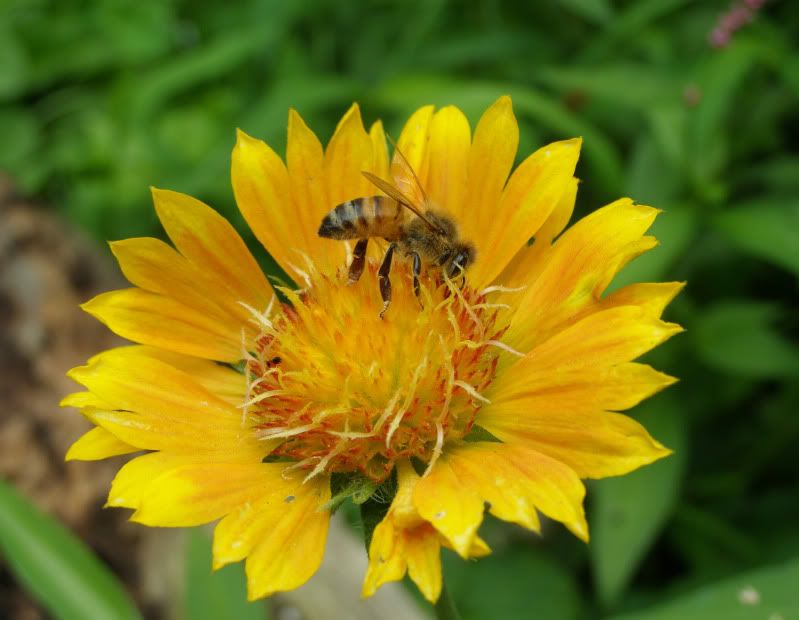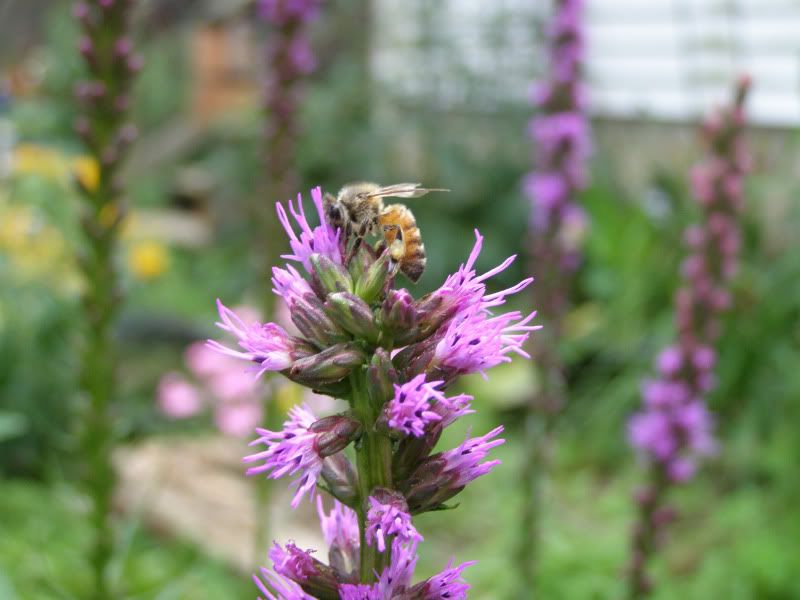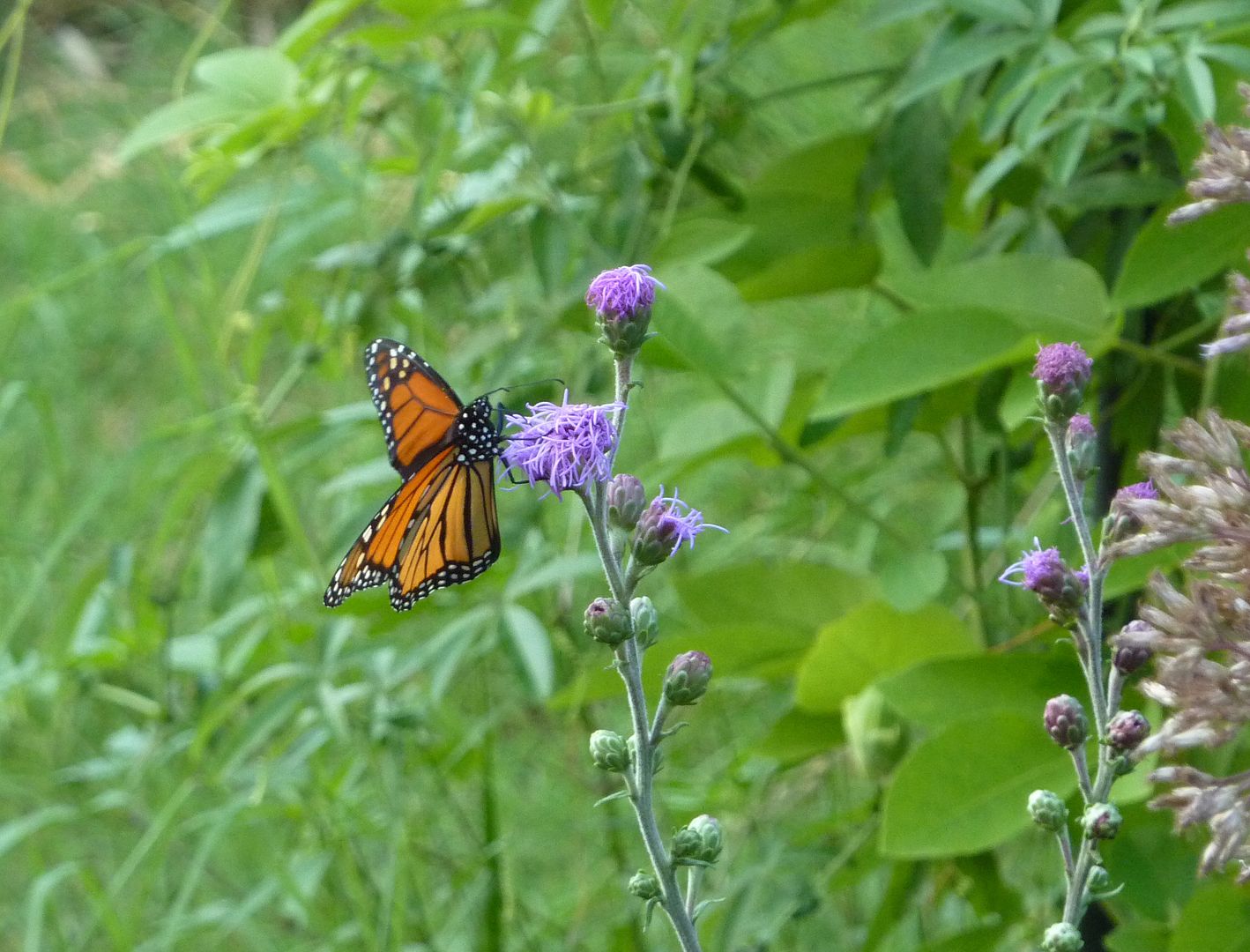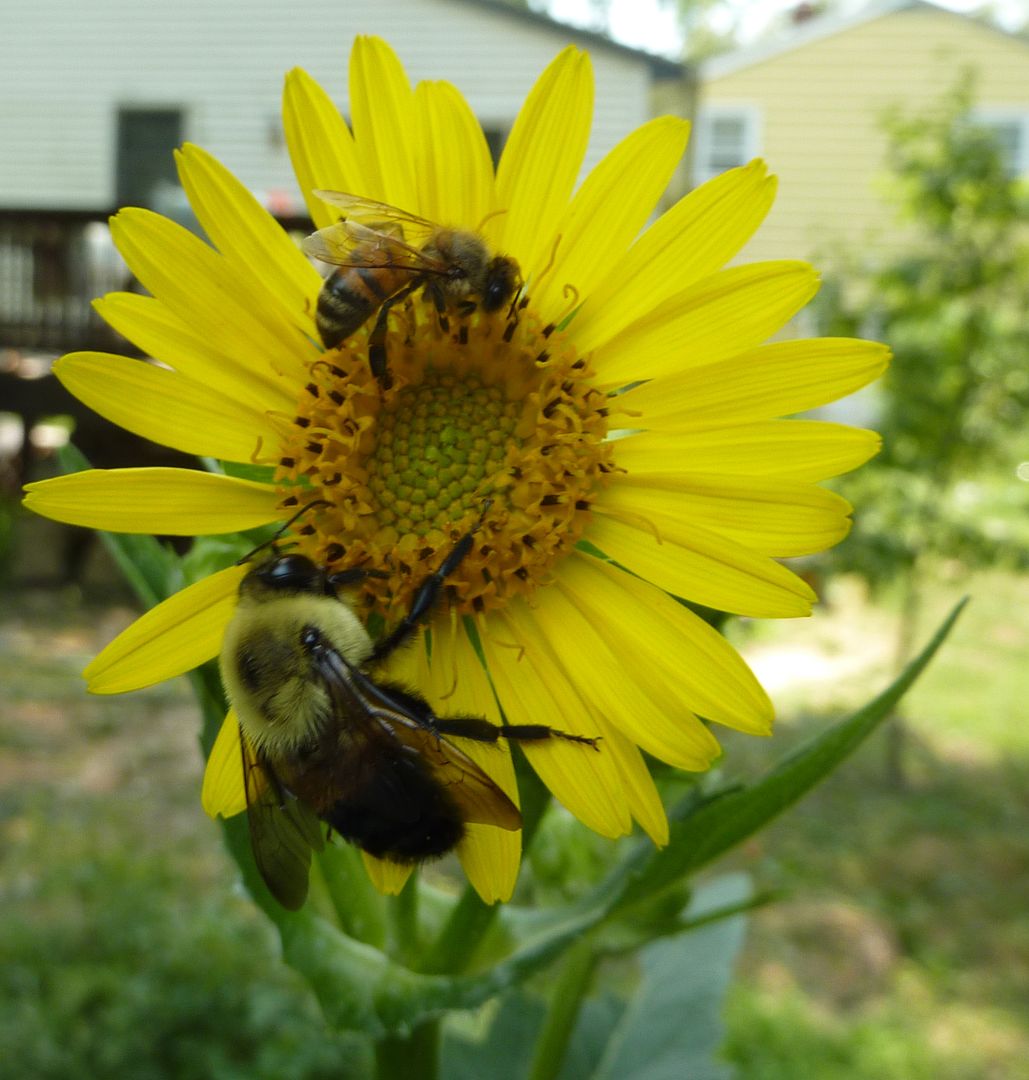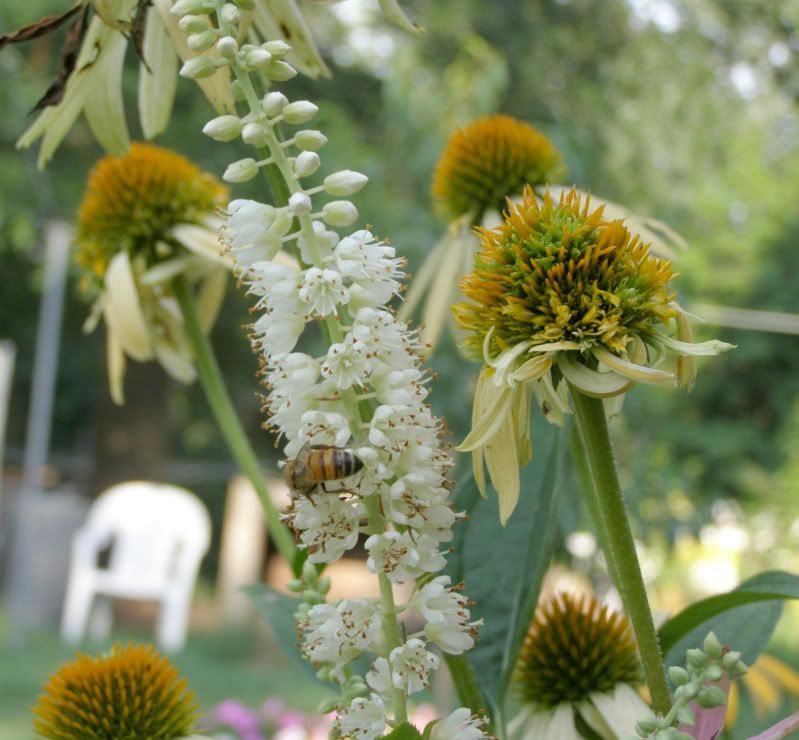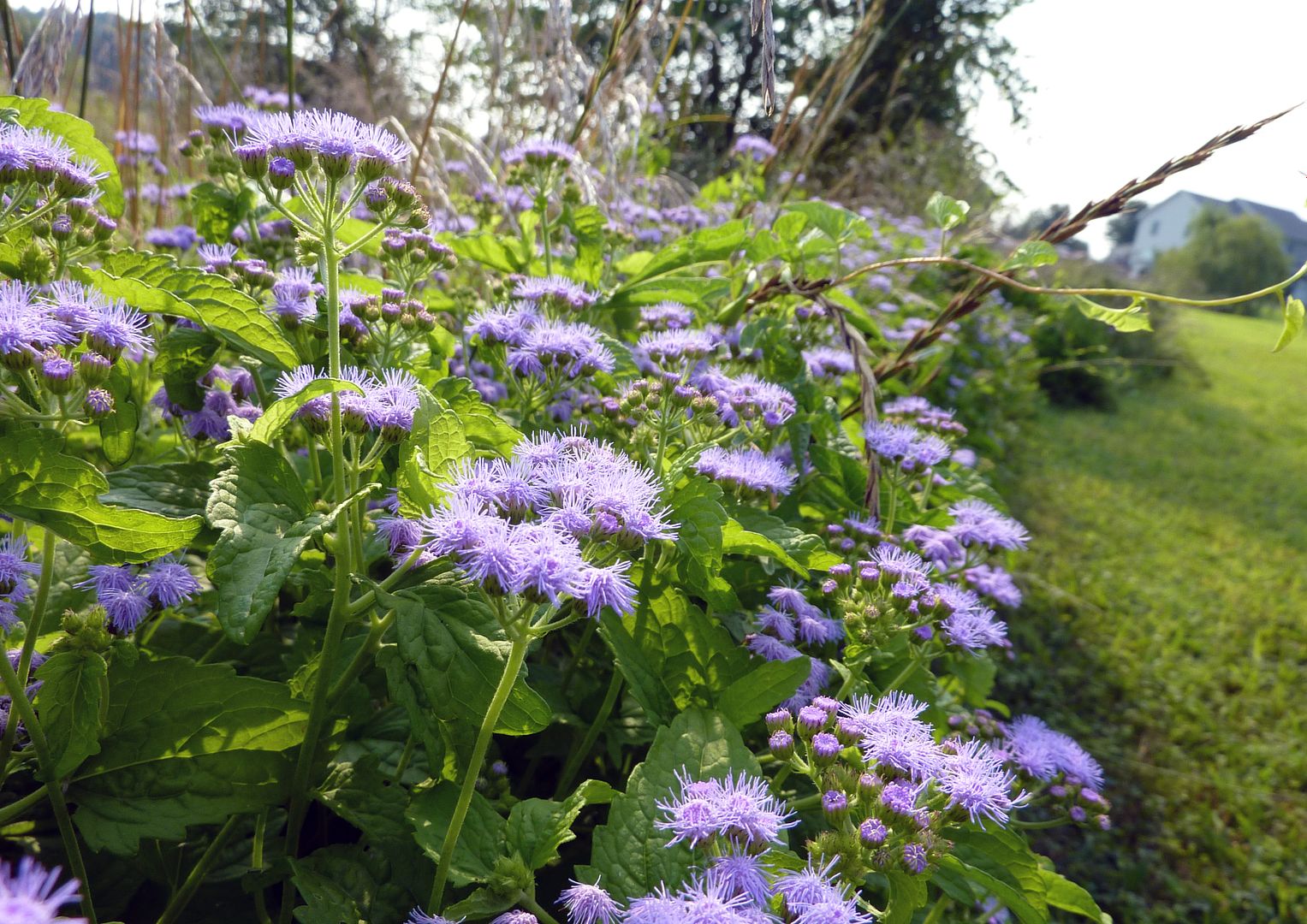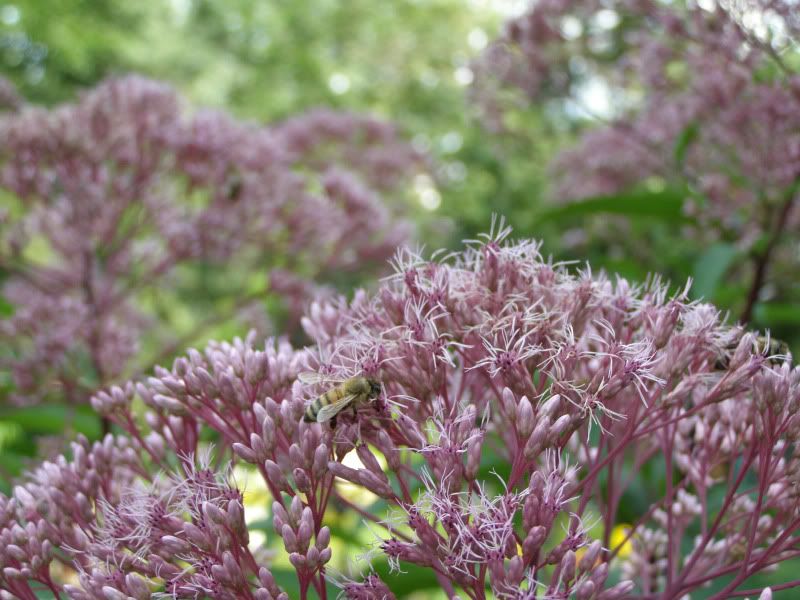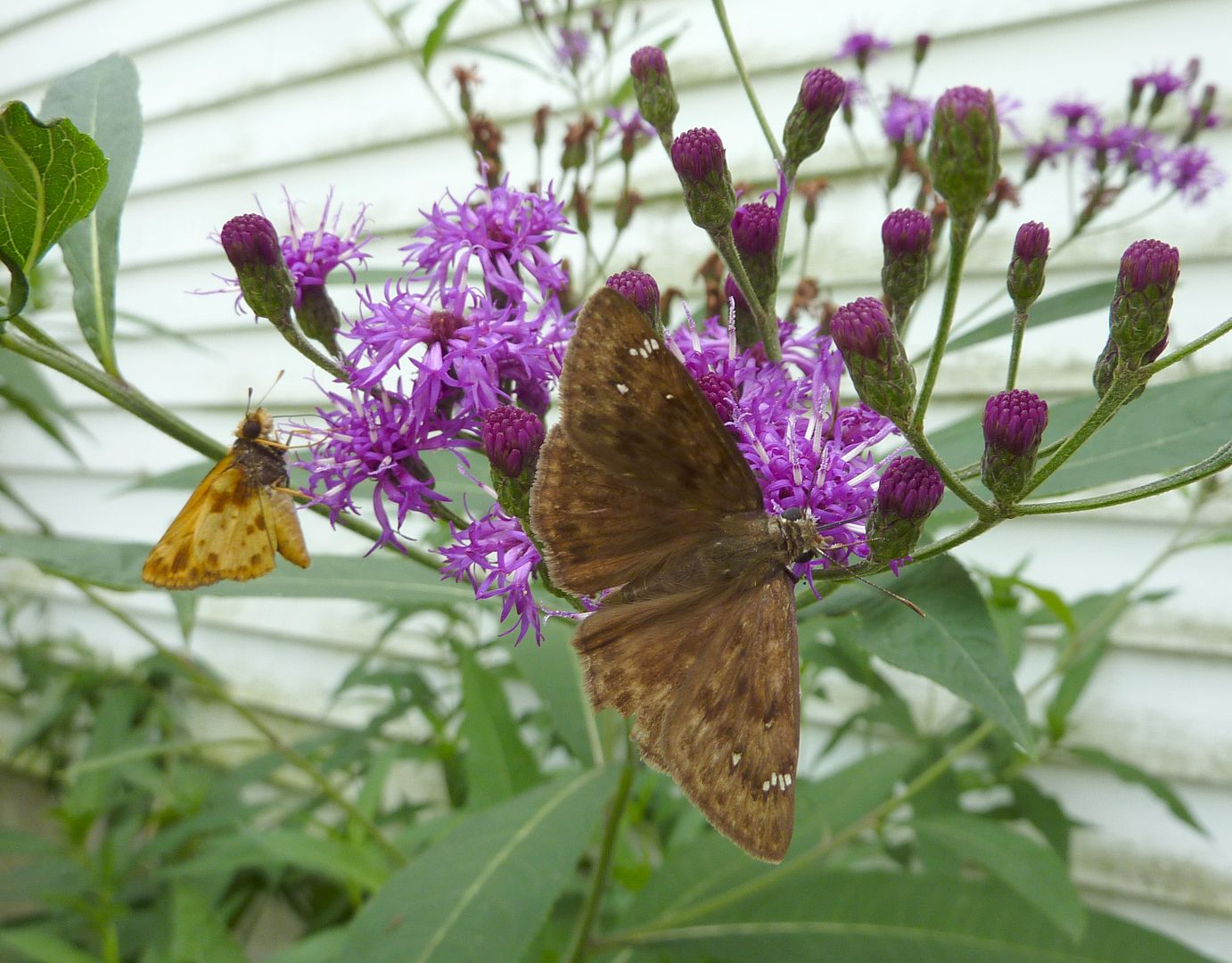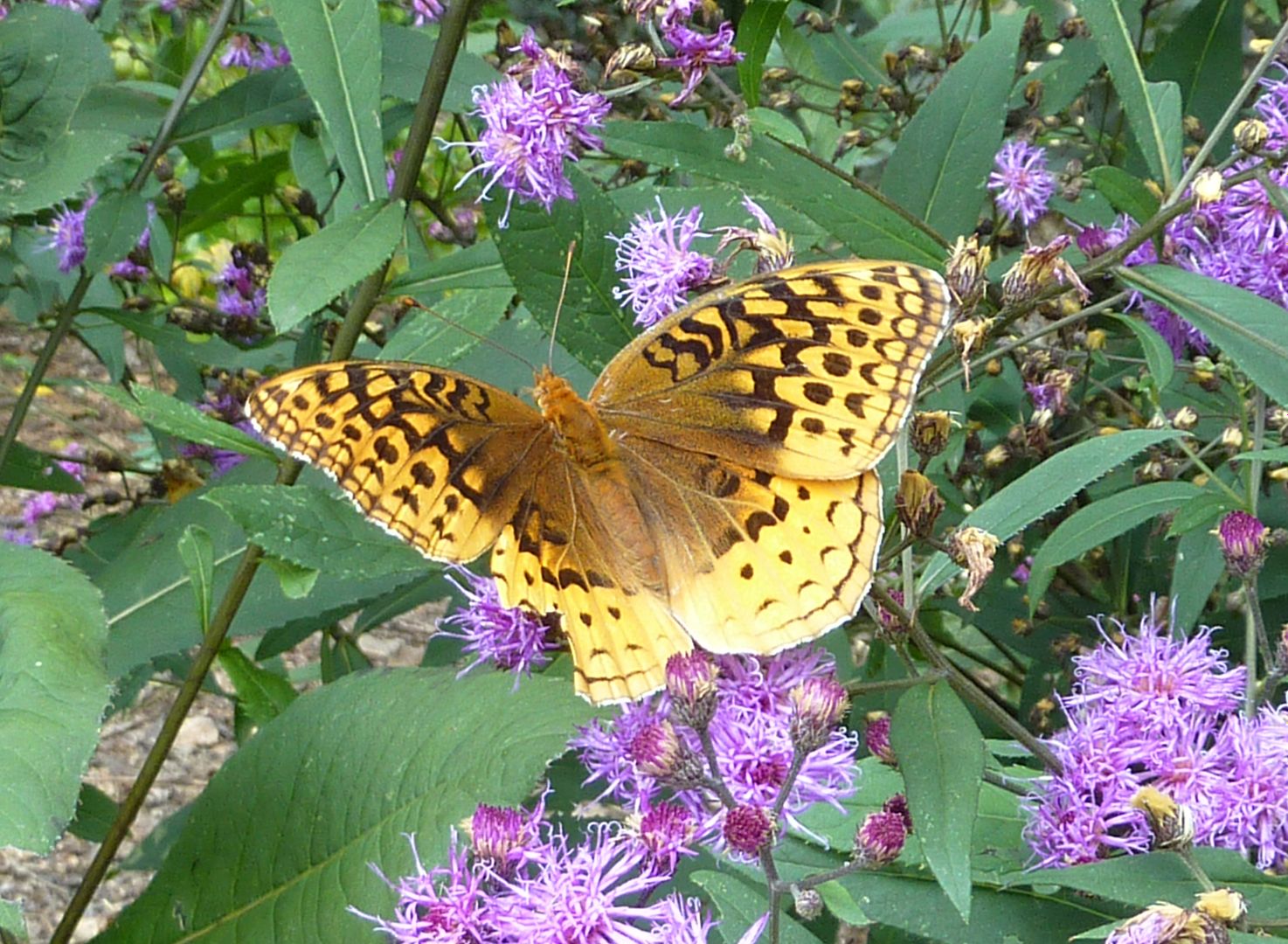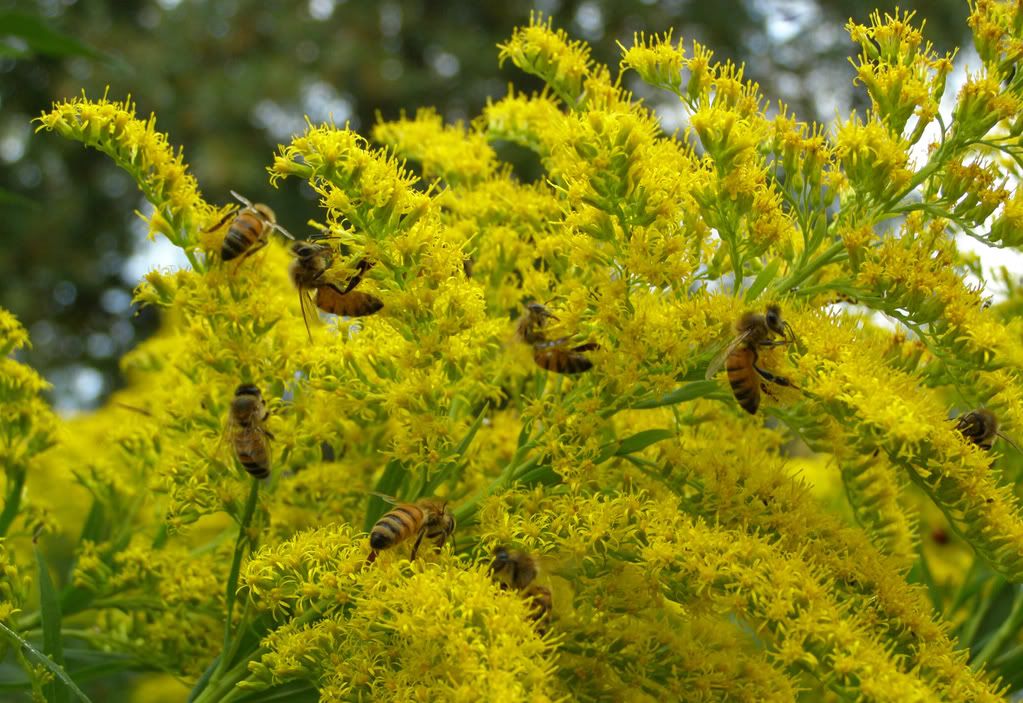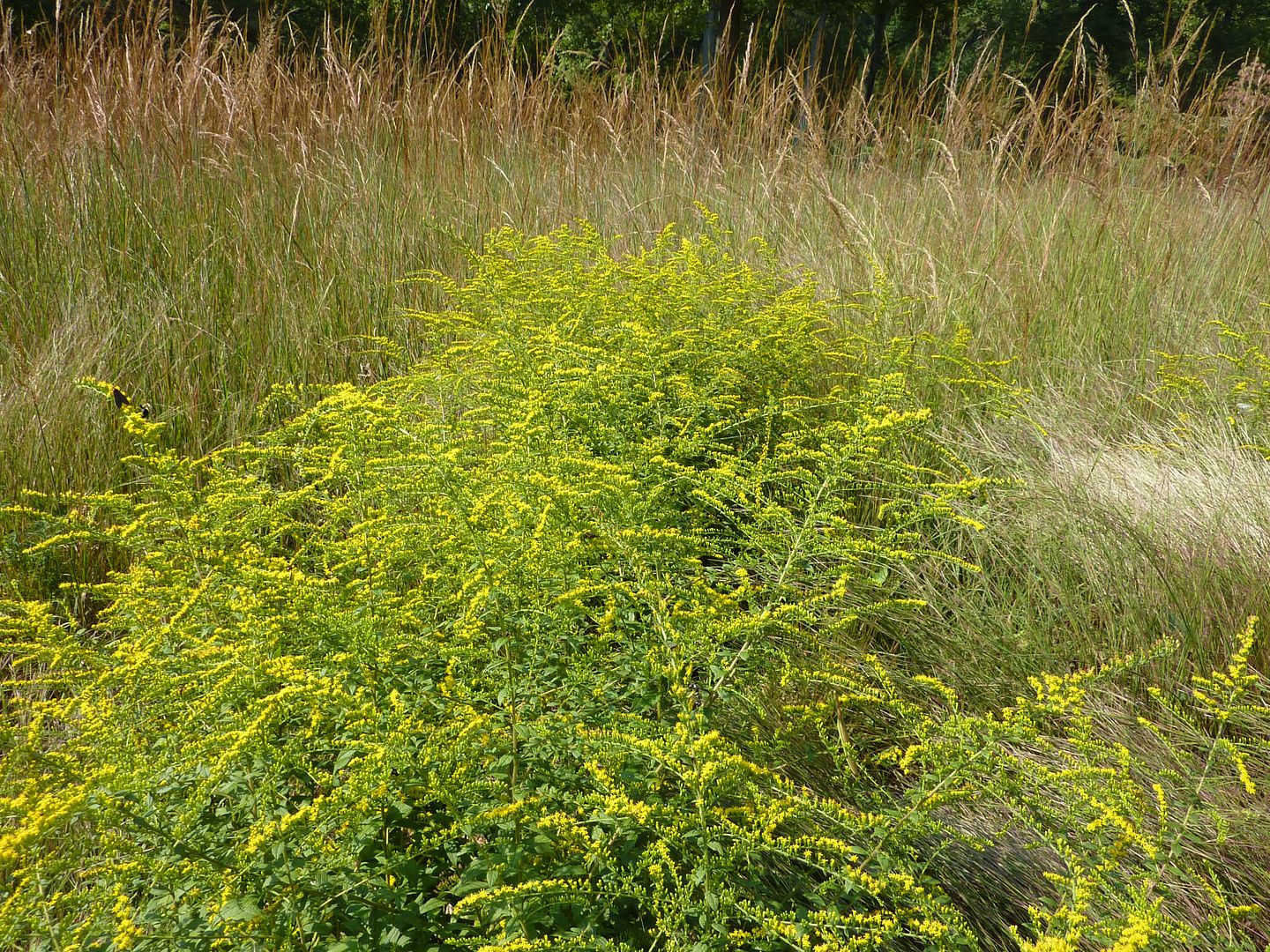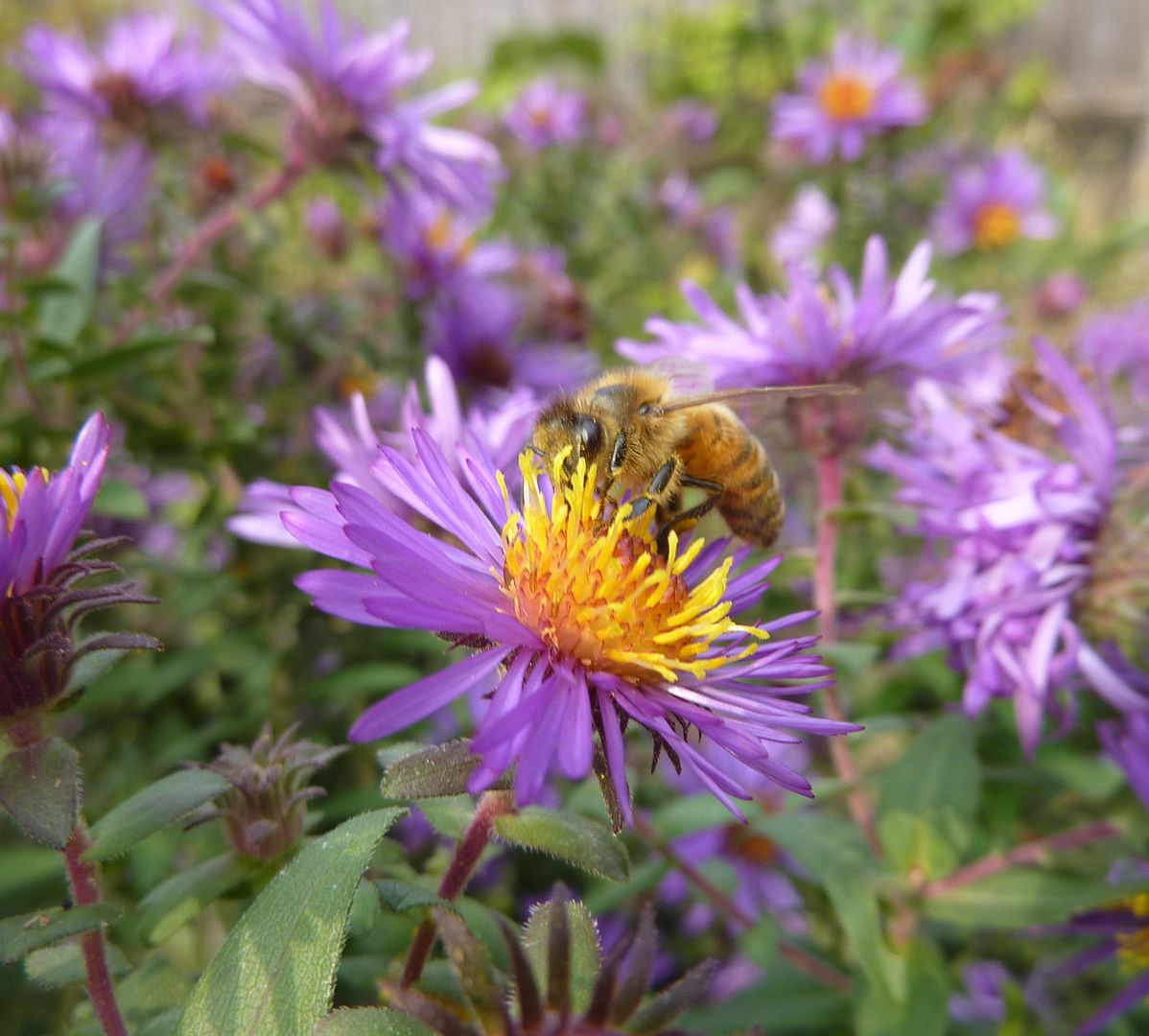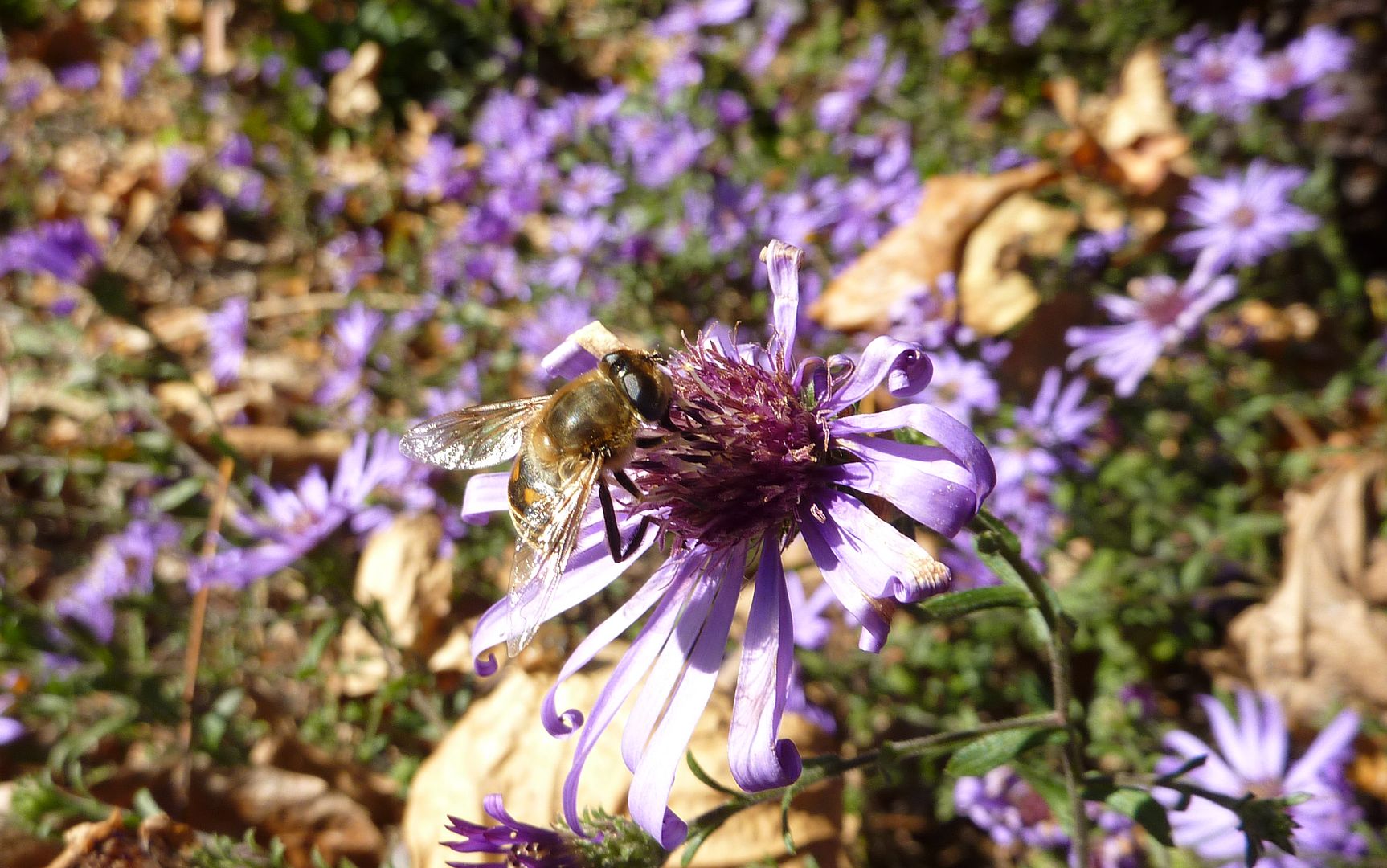This week was when the Trilliums really seemed to peak out in the garden. Trillium grandiflorum has this wonderful white flower that lasts up to two weeks. Most of the first week it's a pure white color, then entering the second week it turns pink and magenta.This plant is stunning if you ever see it growing in mass over a forest floor.
It's also a shame this plant isn't more widely distributed by reputable sources. Even when it's nursery propagated though they tend to be very expensive. I believe every gardener who has a shade garden should own at least on Trillium. Over the years it will form it's own little clump and and if it's producing seed it may multiply considerably over the next decade.
Trillium luteum is one of the few yellow flowering species. It's charm is its matted leaves and sweet lemony scent.
Trillium viridescensflies is another one that does well in my garden. At sundown they start producing the scent of rotting fruit and flies are quick to flock to them. I believe this benefits other Trillium species that happen to be growing around them as the flies will occasionally mistake them for the Trillium they want.
Flowers are very architectural looking. But of course anyone who knows about Trilliums knows that I really grow them for the Ants. Every August they go to seed and the ants start distributing them around my garden. I should really start planting a few of my own and try out germination methods, rather than letting them spring up at the mercy of the lawnmower.
Monday, April 23, 2012
Thursday, April 19, 2012
Native Plants for Honeybees
Some Background
Once upon a time I wasn't a gardener. I got my start as a beekeeper and one year I had the idea to plant some flowers for my bees to help them out. So I drove down to the nursery, bought whatever looked good, came home, and planted the two gardens you see below.
These are some of the prized annuals and perennials of the landscaping industry. They're an instant splash of color, and as I later found out, most are completely worthless nectar sources. All summer and autumn I didn't find a single honeybee, or any bees for that matter work any of these flowers. (Flowering plants make pollen and nectar to feed bees, and without this trait really what is the point?)
This is my second attempt the following year. As you can see few of the original plantings remain. This garden had the same problem the first one did with almost no bee activity what so ever.
Among the plants I bought though, one happened to be a Butterfly Bush. This was getting attention but the more I read about them and had it the less I liked it.
What I did like though were the butterflies! Here is a Monarch butterfly. I wasn't that great of a photographer, and didn't have as nice a camera then, but I wanted more of these around so I could take pictures.
Honeybees do work Butterfly Bush, however, it's rarely worth the number of foragers for the size of the plant. People who have 10' tall hedges of several plants though tell me they get swarmed with Honeybees. That's great and all but it's really not a plant I recommend. I've noticed around the neighborhood, it's rare that people keep them planted in their landscape for more than a few years. They just grow too quickly. People who plant Lilac on the other hand tend to keep them around. The problem is they're fast growing and want to grow into an enormous 10' by 10' shrubs. The flowers smell like rotting fruit (but somehow lack the repelling qualities), also they spread prolifically in wetland areas. Dead heading is always an option but you'll be trimming them every day into ever less appealing shapes.
In the Butterfly Bush's defense, there are dwarf varieties, and I'm at a complete loss to think of a better nectar source for butterflies that flower as long as this plant does. So it's worth a try but irresponsible to plant one near a wetland area. They seem more like a novelty plant; something one buys because the kids or mom want to have a butterfly garden.
So I got rid of the Butterfly Bush as I wasn't willing to commit to it. While hacking away at the branches though I realized one shoot wasn't attached at all. The leaves were very similar but different somehow. So I kept that one and later that Autumn I found out what it was.
Goldenrod. Yes this is a picture of what would later become The Amazing Goldenrod, Solidago altissima, that started out as a single timid 7' cane emerging from the ground.
This plant was getting honeybee attention, along with every other pollinator around at the time, and it was doing it in September and November, a time when honeybees need to store for the winter. I thought to myself, "How could I ever weed such a wonderful plant out?" So I let it grow in the garden, and today it spreads somewhat aggressively by root suckers that are easily controlled by plucking right out of the ground. The earlier in the year the easier to pull, I've found. Some of the central canes grow to be 13' tall. Now I know I was just complaining about how massive a Butterfly Bush gets, but this plant I can shape and divide easily, and it doesn't need daily pruning. Unlike the Butterfly Bush, this isn't a novelty in the garden, it's history, a plant that was growing in this country well before Columbus stepped foot here.
Why Plant Native
Honeybees, Apis mellifera, are not native to North America so why should a beekeeper care about native plants? This is a valid question and one that I like to sum up by saying "Nectar." If we honestly judged how healthy an ecosystem was based on the sources of nectar available then all we'd have to do is fill our socks with apple sauce and hang them out to dry. Think of how many nature preserve we could replace by doing that! Whether it's nectar from a flower, the carbohydrates of a fruit, or soda spilled along the street, honeybees consider these food and don't care much about the source or quality of where it's coming from.
The local Pepsi Plant one summer spilled an entire vat of High Fructose Corn Syrup that filled the parking lot and loading bay area with the sweet sugar. It wasn't long before every bee, wasp, and house fly in a five mile radios blacked the sky to get at it. There were so many bees there in fact that an employee called the president of the south chapter of the New Jersey Beekeeping Association in as a consultant. There were so many bees flying around that their employees were afraid to go out there. Generally he told them to wash it all away (then regretted not going there in person to charge thousands of dollars just so he could hose down a parking lot).
On a small scale if you spill a soda on the street, or load up a dumpster with half full cans of cat food, and such, bees are going to find it! They're going to sip it up as though it were nectar and mix it in right with the honey. This is why I tell people to wash out their recycled cans once before placing it in the bin.
Hummingbird feeders are frequently raided for sugar water, and many have special guard pieces over the holes just so hummingbirds are left with something to eat. So overall nectar just isn't a good way to measure the success of anything other than to say there is food.
Even with a fair amount of the foragers working none flower sources for food, the majority of the hives foragers are still out collecting food from these places. Public feeding of bees should be discouraged, especially later in the year when Yellow Jackets and Bald Faced Hornet populations start to peak. Instead we should be planting more flowering plants that the bees enjoy.
Honeybee hives are perennial, maintain populations of 20,000 to 80,000 bees year round. That means they need to forage all year long. An issue faced by most species of bee is the fact that flowers vary in size and color from plant to plant.
The flowers of an apple tree are about as simple as they come.
Trying to figure out how a passionflower works though can be somewhat perplexing.
The tube shaped flowers of a honeysuckle would be impossible for any bee to pollinate. Honeybees even struggle pollinating blueberries because the flowers are more bell-like and they don't have enough access to the pollen within. In both cases there are carpenter bees that come along and cut holes in the flowers but this results in the honeybees stealing the nectar and not pollinating anything.
Now with so much flower diversity going on, and the need for a constant food source, evolution has shaped the honeybee into an all around generalist pollinator. They tend to work best on simple flowers. You will occasionally find them working Bee Balm, or Monarda, but both of these require the bee to pry open the flower to get at the nectar and that's a task more suited for a Bumblebee. Stick with flowers in the Composite/Aster, Rose, and Mint Family for the best results.
But now we come to an environmental issue. Nonnative plants don't fit into the environment as well as their native counterparts. Fewer insects eat their leaves, and in places where nonnatives dominate that can be a major part of the food chain missing. Honeybees are notorious pollinators of Japanese Knotweed, Purple Loosestrife, Popcorn Trees, Catmint, Vitex, Bradford Pears, and dozens of other imported plants who's status varies from invasive to on watch lists from state to state. It's likely because honeybees evolved with these plants from Asia, Africa, and Europe that they are actually better at pollinating them than our native bees. As none of these are food crops though beekeepers shouldn't view the incoming nectar as a real benefit. As far as the environment is concerned, you might as well have fed them sugar water.
Don't Waste Their Time
Honeybees are a victim of their own success.
I pulled 64 jars of honey out of 2 hives one year, with the majority of it coming from one of the two. To put this in perspective, the average bumblebee hive stores enough honey to last 7 to 12 days. Where as the larger of the two honeybee hives had filled up more than half the hive with food.
At the heart of this industry is a queen bee who lays 2000 eggs on a good day. Every 21 days afterward another 2000 worker bees are born. 12 days after birth they join the foraging labor in an effort to sustain the hive. Those that find rich and abundant sources of nectar will return to the hive, and preform a waggle dance, an elegant display of trigonometry that conveys to the fellow bees where the food is. The effect tends to snowball as abundant food sources are locked onto. Whole patches of perfectly good flowers can be overlooked all because they weren't best of show.
A single plant of one species in a mixed field of other species won't get the same attention as an entire field of just that one plant species. This is what makes honeybees great for pollinating farm crops. The problem with only pollinating farm crops though is it isn't sustainable for the hive to only work one plant. Commercial Beekeepers have to constantly move their hives around, deal with pesticides, and god forbid the occasional car accident. If there aren't nectar sources or sugars to be exploited then it's a dead zone of activity for the bees. The answer to this problem is meeting somewhere in the middle. If we take that same field and fill it with an abundance of plant species that collectively flower all year long, while also grouping similar plants together, then we have a year round food source in a way for the bees.
Here a farmer is growing mustard (not native). For the few weeks in spring that this plant flowers honeybees will love it, but once this crop stops blooming they'll be far more interested in what's going on in the forest behind his fields. As most trees don't flower in the summer time their foraging will be limited.
This isn't just for farmers either. To the left here is a lawn that's doing nothing. I'm sure there are some weeds that flower but overall this is a year long dead zone. To the right however is a shallow wetland area that's too dangerous to mow and thus allowed to grow on the wild side. The trees there are willows which offer nectar in the late winter, early spring time. They're also a host plant for the Viceroy Butterfly, which is a mimic of the Monarch Butterfly.
Native plants don't have to look messy at all. Go ahead and incorporate them right into the garden, even if they're with nonnatives.
If you have a forest edge on your property then go ahead and separate it with a garden area. This is a perfect location for fruit trees, herbs and perennials. It's fine to not be 100% native but these other plants shouldn't just be there for looks. Nonnative plants should be a food crop or otherwise not invasive.
As previously mentioned, not all flowers are made equal. Some plants require a greater number in order to start getting bee attention. Pictured above is a honeybee on a Black Eyed Susan, Rudbeckia sp. This is a rare sight in my experience. They're an easy biannual plant to grow from seed, offer great color, but are not a hit with the honeybees unless there are a lot of them. Milkweed, Asclepias sp., are far more prized by honeybees and take up about the same amount of space.
For a more in depth look at the importances of native plants consider reading "Bringing Nature Home: How You Can Sustain Wildlife with Native Plants, Updated and Expanded" by Doug Tallamy.
by Doug Tallamy.
The Plant List
Honeybee hives spread by division and it's not surprising that this most often happens in the spring time when most trees flower. If you have a forest around you or live in a fairly wooded community then you don't need to plant a whole lot for the spring time. A single tree in bloom can get all the attention than whole slues of wildflowers growing beneath them. Many of these wildflower ephemerals get pollinated by flies, beetles, or native bees which are less picky about where their food comes from so long as they can work the flower. Towards the end of spring and start of summer the tables turn as most trees start to produce fruit or seed. Sun loving wildflowers take center stage from then on. However, during the transition from spring to summer there is a notable drought of nectar sources that I'm at a loss to fill in adequately at this time.
So let's begin.
Most Willows, Salix sp. are wind pollinated, however bees never pass up on a free meal especially when the plant is offering it so willingly. (Over the summer time Corn is an excellent source of pollen for the same reason!) Even with this source of food though it's best to feed your hive sugar water just to help them over the hump before everything gets going. Honeybees will forage whenever it's 45F or higher outside and those days can be come and go early on. Maples, Oaks, Hazelnut, Most Fruit Trees, Redbuds, Dogwoods, Birch, Poplar, Tulip Trees, Magnolias (native and non), Nut Trees and just about everything else in the forest are quick to start flowering afterward.
Anyone interested in giving a home to a native tree that's extinct in the wild should consider the Franklinia, Franklinia alatamaha. Originally this plant was only native to Georgia, it's actually been found to be much more able to grow up north without much problem. They bloom over the summer time with great big Magnolia-like flowers that look very inviting and bee friendly in my opinion. I would sooner plant one of these over a Crape Myrtle, or Seven Son Tree, simple because it's at least native to North America, while the other two are imports from Asia.
Jacob’s Ladder, Polemonium caeruleum, is a very versatile native perennial that flowers in the spring and can handle full sun to full shade, dry to fairly wet, and grows in most soil types. A reliable source tells me Honeybees visit the flowers but so far I haven't seen anything bothering with them, but this is their first year blooming in the garden so we'll see what happens.
Mountain Mint, Pycnanthemum sp. Generally anything in the Mint Family is treasured by bees and this plant is no exception. Mints can be a little aggressive though and sure enough this plant can send out root suckers 3' away from the original plant. Weeding them out so far has been as simple as pulling them so it's easy to control and the leaves smell wonderful. It's quick to start growing each spring and tends to flower around the late spring early summer transition.
Sumac Trees and Black Locust, Robinia pseudoacacia both flower around this transition time. Where I am in NJ Locust trees are a major source of nectar. Their blooming doesn't always line up with this transition time perfectly, so some years they're ahead while others they're behind.
Later in the summer one of the latest Sumacs to flower is the Winged sumac, Rhus copallinum. And it steals all the attention. It's actually a shrub that is commonly seen along forest edges and highways. The flower clumps are green though so it's often overlooked. The tiny flower shape allows for all sorts of pollinators to gain access to the nectar, however the flow seems to die down by 4:00pm each day. I've also noticed this plant doesn't flower well in droughts, and the flower buds are easy to fall off the plant during harsh storms. Sadly this wonderful nectar source is hit or miss each year.
I'd recommend it as a landscaping shrub if it weren't for the fact it sends up root suckers. Whenever you find them in the wild they're always in clusters along a forest edge, making their own grove. Some specimens can reach 30' tall but this isn't that common.
Tickseed, Coreopsis. There are loads of easy to grow species of Coreopsis out there that come in all sizes. The tallest one I know of is C. tripteris, which gets to be 7' tall! The genus is otherwise mostly small roadside plants. While I wouldn't say they're lusted after by honeybees, they're a major group of plants for some our native bees. Many species will aggressively divide by rhizomes underground or will more timidly spread around by seed.
Coneflowers, Echinacea sp. These are a tried and true wildflower. In mass they're a food source to Goldfinches and to bees they're a fair nectar and pollen source in their own right. Plants that have been started by seed tend to be great at seeding themselves around. Cultivars and nursery grown plants don't seem to be as prolific. Many cultivars don't seem to make as much pollen as they should either. Another failing is Aster Yellows Disease. This infection causes the plant to make green monstrosities instead of real flowers, and sadly the only cure is to remove the entire plant. The disease is spread by aphids, and the common dandelion is a carrier. In the interest of flowers, effected plants should be weeded out immediately and their foliage put right in the trash.
Anise Hyssop, Agastache foeniculum. If ever there were a universally accepted bee plant in the world, this would be it. New Jersey has about 2,000 beekeepers in the state and I'll bet money that most of them know about this plant. They look great in the garden, and most days bees will be working the flowers from sunup to sundown. You couldn't ask for more of a bee plant.
Though technically I think they're a mint plant, they are not aggressive spreading at all which is surprising from a plant that gets this much attention!
Black Eyed Susan, Rudbeckia sp. This group barely made my list. I have seen great big clumps of this plant with nothing working them. But then I'll occasionally see a bee working one or two flowers, that might not even on a plant with the largest gathering of flowers. I feel like this was a poor nectar plant to begin with that's been selectively bread somewhat so it makes even less pollen and nectar, or in some cases more. Whatever the case, this plant sometimes works and sometimes doesn't. Skip it in favor of other plants on this list if you're on the fence about it. At the same time though I'll say you could certainly plant worse, and they're cheaply started by seed.
Spiderwort, Tradescantia sp. This is a new plant for me. I think of it as an ornamental onion with some pretty little flowers that only open in the morning and are quick to vanish by mid afternoon. Honeybees pay good attention to it even when there are few of them of them open (6 or less). So that's got my attention and I'd be curious to see what they do when given a field to work with. Plants have a nice grass-like appearance which can be an alternative to meadow grasses for people looking for a meadow that leans towards wildflowers.
Sunflower, Helianthus annuus. Sunflower seeds are a lesson in how amazing an annual can be. When one thinks of a tiny seed smaller than their fingernail few people realize that in just a few months it can be a massive tree-like plant with more than 50 flower heads blooming all at once. Sadly few seed pack grown varieties yield the aggressive potency found in wild strains. The genetics is certainly there if one saves seeds each year. Often annual sunflowers that come back the following year seem to grow much taller and more vigorous than their parents did. Honeybees mostly use these just for pollen and often one finds them working the flowers almost on accident. There was a study once that found Honeybees would only work the flowers to one variety after seeing a bumblebee on it. Native bees are far more common visitors of these but the attraction of sunflowers shouldn't be avoided. Pollen is important for a honeybee hive, and Goldfinches are regular visitors of the flowers. I try to plant $5 worth of seeds every year.
It's worth mentioning that there are also perennial sunflowers, however I've noticed most of them bloom in late summer, early autumn when Asters and Goldenrods seem to take center stage. Of ~50 species in the U.S. I'm sure one of them does a great job at getting honeybee attention, I just haven't found it yet.
Buttonbush, Cephalanthus occidentalis. Think of this plant as a native Butterfly Bush. This shrub blooms in the summer with lots of tiny balls of white flowers. Sadly they are short lived with each cluster lasting maybe 4 days but this is done in succession on the plant. As one closes, another one seems to open. Even with few flowers open at a time though honeybees still stop to work them. I've been told it's a rare sight to see one of these plants in bloom that didn't have a swallowtail on it too. I don't think they love it that much but I do find swallowtails flocking to them. As with the Butterfly Bush, this plant wants to turn into a 10' by 10' shrub but does it at a slow and steady pace. They love getting their feet wet too. In the wild plants don't mind growing in up to 4' of water.
Culver’s Root, Veronicastrum virginicum. I have this plant on order but so far I like what I see on youtube.
Milkweeds, Asclepias sp. This host plant to the Monarch Butterfly is an excellent nectar plant, and many species bloom from late spring to the end of summer. Some beekeepers don't like it though because the anther sacks get stuck to the bee's legs and it's not uncommon to find bees dangling helplessly under flowers. This actually isn't what kills them though so beekeepers shouldn't be afraid to plant this wonderful wildflower. What's happening is assassin bugs take advantage of the situation and use it as their time to strike. Assassin bugs can be found on any plant though and regularly kill honeybees on Russian Sage, Anise Hyssop, and I'm sure lots of others. The difference here is when killed on Milkweed the bee corps is still hanging from the plant.
Stokes Aster, Stokesia laevis. Honeybees will work this plant despite the lack of flowers in comparison to other plants. Sadly it's not one that's ever done well in my garden. I recall it getting more attention than the Coneflowers next to it though.
Blanket Flower, Gaillardia grandiflora. This is a nice wildflower that's great for filling out a lot of space. When planted in the hot, sunny, dry places that it likes the plants tend to fan out like a mum, blooming in the summertime and cover itself in flowers. Cultivars come in solid yellow (as seen above), true species with a red ring in the middle, and solid red. Honeybees don't actually care if the flower is red in this case but for those who believe it makes a difference, then go ahead and stick with solid yellow forms.
Blazing Star, Liatris sp. This is among the easiest of native wildflowers to find in mass production. They're cheap too at around $7 for 12 to 50 plants. The roots are small potato-like corms that can be planted in mass all in the same hole, but spread out so as not to overlap too much. Each plant produces a single stem covered in thin grass-like leaves with the flower column at the top. Oddly enough flowers at the top open first and they work their way down on a last grown first to flower basis. Goldfinches will eat the seeds but it's not as commonly seen as on sunflowers. Plants will slowly divide underground but because this is done at an upward angle rodents are quick to eat the new plants. In the wild, Liatris species seem to do best around dense grasses where these new divisions are better protected. In the garden a thin layer of mulch can help.
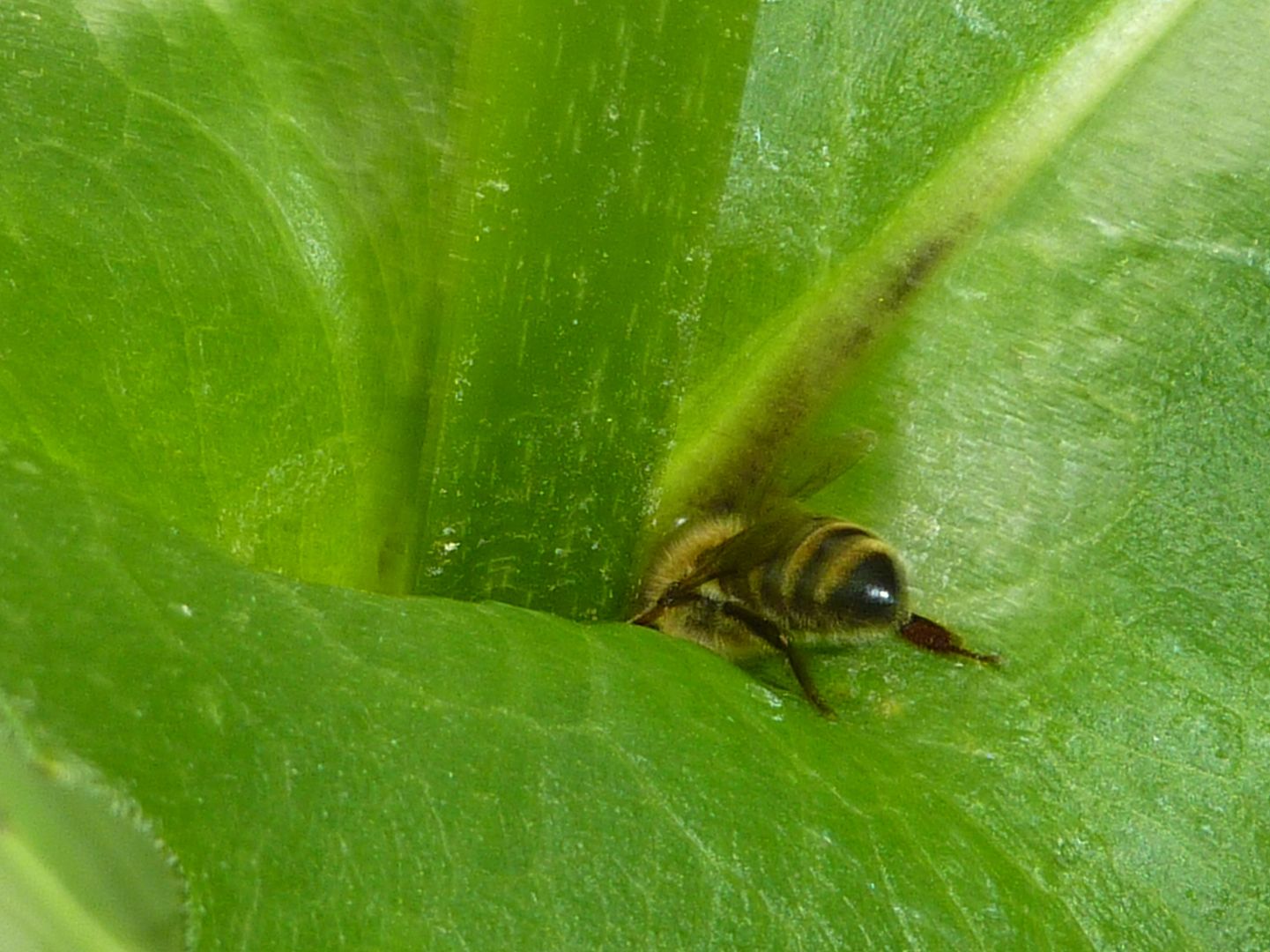 I feel like this plant gets more environmental praise than it deserves. The leaves form little cups all along the stem and fill with a rather pitiful amount of water. While I have seen bees and birds drinking at these it doesn't happen anywhere near as often as you'd think. Reports of frogs laying eggs inside the leaves I'll believe when I see it in person, because the wells don't fill for much longer than two days. In truth these small pools of water are a defense against ants steal nectar from the flowers above. Other members of the Silphium genus don't have these cups but are equally good at attracting pollinators.
I feel like this plant gets more environmental praise than it deserves. The leaves form little cups all along the stem and fill with a rather pitiful amount of water. While I have seen bees and birds drinking at these it doesn't happen anywhere near as often as you'd think. Reports of frogs laying eggs inside the leaves I'll believe when I see it in person, because the wells don't fill for much longer than two days. In truth these small pools of water are a defense against ants steal nectar from the flowers above. Other members of the Silphium genus don't have these cups but are equally good at attracting pollinators.
St. John's Wort, Hypericum sp. This plant blooms right in the middle of summertime when bees need it most. Tragically blooms don't seem to last much longer than 5 days. Species of this plant come in both shrub and herbaceous perennial form. Some are longer blooming than others but I haven't studied the genus in depth that much yet. Pictured above is an unidentified shrub form that for all I know isn't even native, but that's not going to stop me from growing it, as long as it's not a weed. I can live with a 50/50 chance of native or not.
NOTE: Hypericum perforatum is an invasive nonnative plant. It's a herbaceous perennial form that spreads like the plague and is toxic to livestock.
Summersweet, Clethra alnifolia. This plant is also called Sailor's Delight because its fragrance could be smelled far out at sea. This is an excellent summer blooming shrub. It's a little late to leaf out in the spring but that's about it's only fault. They are shade tolerant but will grow happily in full sun too. They normally grow along streams and have a wonderful scent. The strength of this delightful fragrance seems to vary depending on various conditions. One plant I could smell from several yards away and was absolutely mobbed with what had to be the highest diversity of pollinators I'd ever seen in one place. To date though I've never seen any other plants getting that much attention.
Joe Pye Weed, Eutrochium sp. formerly Eupatorium. As a public service announcement, the genus Eupatorium has been split into 3 genera now. I'm no botanist but here's how I think they've divided the genus.
Eupatorium is now comprised of all the (mostly) white flowering Boneset plants. These gets lots of pollinators but I've noticed odd types of wasps favoring them mostly.
Conoclinium is now comprised of all the blue/indigo flowering ... uhh Blue Mist Flowers. Conoclinium coelestinum is the only species I know of in this group. I've seen pictures of Monarch butterflies on them, but rarely do I see bees or anything else for that matter.
Eutrochium is where it's at! These are the pink/purple/magenta flowering Joe Pye Weeds. These are massive perennials that form large clumps with canes reaching up to 12' tall, though stopping between 6' and 8' is more common. There are also dwarf versions that only reach 4' high. Butterflies love them, bees love them, I love them! When the afternoon shade finally hits the flowers a very medicinal scent starts to emanate from the plant. When it comes down to money vs. nectar production this is one of the best bangs for your buck. They will take up a lot of space when they get big, and on some years they will flop over, but they're worth it.
Ironweed, Vernonia sp. This is another one of those plants that I read and people tell me that it attracts a lot of butterflies and bees. I believe them on the butterflies but the bees... so far not so much. This is another tall perennial like the Joe Pye Weed, but tends to have a more up right habit.
Goldenrod, Solidago sp. Even the aggressive Canadian Goldenrod can be controlled in a garden by simply pulling up the canes early on in the year. They pull right out of the ground and are otherwise shallow rooted enough that a shovel makes quick work of them. Pulling out of the ground is easier to do early in the year when it's still cold out and canes are only a few inches tall. As their smaller feeder roots swarm out into the soil they become far more difficult to remove.
Solidago rugosa tends to be more timid spreading but still pushes up easily controlled root suckers. The cultivar 'Fireworks' is a good one to go for. As the name suggests they flower out on what look like shooting firework explosions.
Solidago spacelata 'Golden Fleece' is a low growing ground cover that gets some attention too.
Asters, Symphyotrichum genus. As another public service announcement. Asters in North America are called Asters in common name only. (They are NOT MUMS and have nothing to do with them! Chrysanthemums are a very similar looking genus of plant imported from Asia.) Asters in North America has been broken up into 7 genera that are somewhat easily distinguish by the flowers. Symphyotrichum is the one you want. Here are a few suggestions.
New England Aster, Symphyotrichum novae-angliae. Video 1, Video 2. Their only failing is that they grow too tall and sometimes fall over. I'm told you can trim them short toward the end of June, (really it's more like the end of July I think!) and they'll turn Mum-like with a neat dome of flowers. I've always been afraid to experiment with this though and have never done it.
New York Aster, Symphyotrichum novi-belgii, tends to be lower growing. However, I've found it to be not as popular as New England Aster. It's a close race though for attention and both plants are worth growing.
Aromatic Aster, Symphyotrichum oblongifolius, is the most well behaved of them all. They have a natural dome forming habit and quickly fill out spaces around them. They have a very minor fragrance to them but it's nothing worth mentioning in my opinion. It's there if you look for it though.
Georgia Aster, Symphyotrichum georgianum, I like to think of as a messier form of Aromatic Aster. I think this is one of the latest flowering Asters in the US as it blooms after the New England Asters have finished.You can even see in my photo leaves from nearby trees have gotten caught in the foliage.
Once upon a time I wasn't a gardener. I got my start as a beekeeper and one year I had the idea to plant some flowers for my bees to help them out. So I drove down to the nursery, bought whatever looked good, came home, and planted the two gardens you see below.
These are some of the prized annuals and perennials of the landscaping industry. They're an instant splash of color, and as I later found out, most are completely worthless nectar sources. All summer and autumn I didn't find a single honeybee, or any bees for that matter work any of these flowers. (Flowering plants make pollen and nectar to feed bees, and without this trait really what is the point?)
This is my second attempt the following year. As you can see few of the original plantings remain. This garden had the same problem the first one did with almost no bee activity what so ever.
Among the plants I bought though, one happened to be a Butterfly Bush. This was getting attention but the more I read about them and had it the less I liked it.
What I did like though were the butterflies! Here is a Monarch butterfly. I wasn't that great of a photographer, and didn't have as nice a camera then, but I wanted more of these around so I could take pictures.
Honeybees do work Butterfly Bush, however, it's rarely worth the number of foragers for the size of the plant. People who have 10' tall hedges of several plants though tell me they get swarmed with Honeybees. That's great and all but it's really not a plant I recommend. I've noticed around the neighborhood, it's rare that people keep them planted in their landscape for more than a few years. They just grow too quickly. People who plant Lilac on the other hand tend to keep them around. The problem is they're fast growing and want to grow into an enormous 10' by 10' shrubs. The flowers smell like rotting fruit (but somehow lack the repelling qualities), also they spread prolifically in wetland areas. Dead heading is always an option but you'll be trimming them every day into ever less appealing shapes.
In the Butterfly Bush's defense, there are dwarf varieties, and I'm at a complete loss to think of a better nectar source for butterflies that flower as long as this plant does. So it's worth a try but irresponsible to plant one near a wetland area. They seem more like a novelty plant; something one buys because the kids or mom want to have a butterfly garden.
So I got rid of the Butterfly Bush as I wasn't willing to commit to it. While hacking away at the branches though I realized one shoot wasn't attached at all. The leaves were very similar but different somehow. So I kept that one and later that Autumn I found out what it was.
Goldenrod. Yes this is a picture of what would later become The Amazing Goldenrod, Solidago altissima, that started out as a single timid 7' cane emerging from the ground.
This plant was getting honeybee attention, along with every other pollinator around at the time, and it was doing it in September and November, a time when honeybees need to store for the winter. I thought to myself, "How could I ever weed such a wonderful plant out?" So I let it grow in the garden, and today it spreads somewhat aggressively by root suckers that are easily controlled by plucking right out of the ground. The earlier in the year the easier to pull, I've found. Some of the central canes grow to be 13' tall. Now I know I was just complaining about how massive a Butterfly Bush gets, but this plant I can shape and divide easily, and it doesn't need daily pruning. Unlike the Butterfly Bush, this isn't a novelty in the garden, it's history, a plant that was growing in this country well before Columbus stepped foot here.
Why Plant Native
Honeybees, Apis mellifera, are not native to North America so why should a beekeeper care about native plants? This is a valid question and one that I like to sum up by saying "Nectar." If we honestly judged how healthy an ecosystem was based on the sources of nectar available then all we'd have to do is fill our socks with apple sauce and hang them out to dry. Think of how many nature preserve we could replace by doing that! Whether it's nectar from a flower, the carbohydrates of a fruit, or soda spilled along the street, honeybees consider these food and don't care much about the source or quality of where it's coming from.
The local Pepsi Plant one summer spilled an entire vat of High Fructose Corn Syrup that filled the parking lot and loading bay area with the sweet sugar. It wasn't long before every bee, wasp, and house fly in a five mile radios blacked the sky to get at it. There were so many bees there in fact that an employee called the president of the south chapter of the New Jersey Beekeeping Association in as a consultant. There were so many bees flying around that their employees were afraid to go out there. Generally he told them to wash it all away (then regretted not going there in person to charge thousands of dollars just so he could hose down a parking lot).
On a small scale if you spill a soda on the street, or load up a dumpster with half full cans of cat food, and such, bees are going to find it! They're going to sip it up as though it were nectar and mix it in right with the honey. This is why I tell people to wash out their recycled cans once before placing it in the bin.
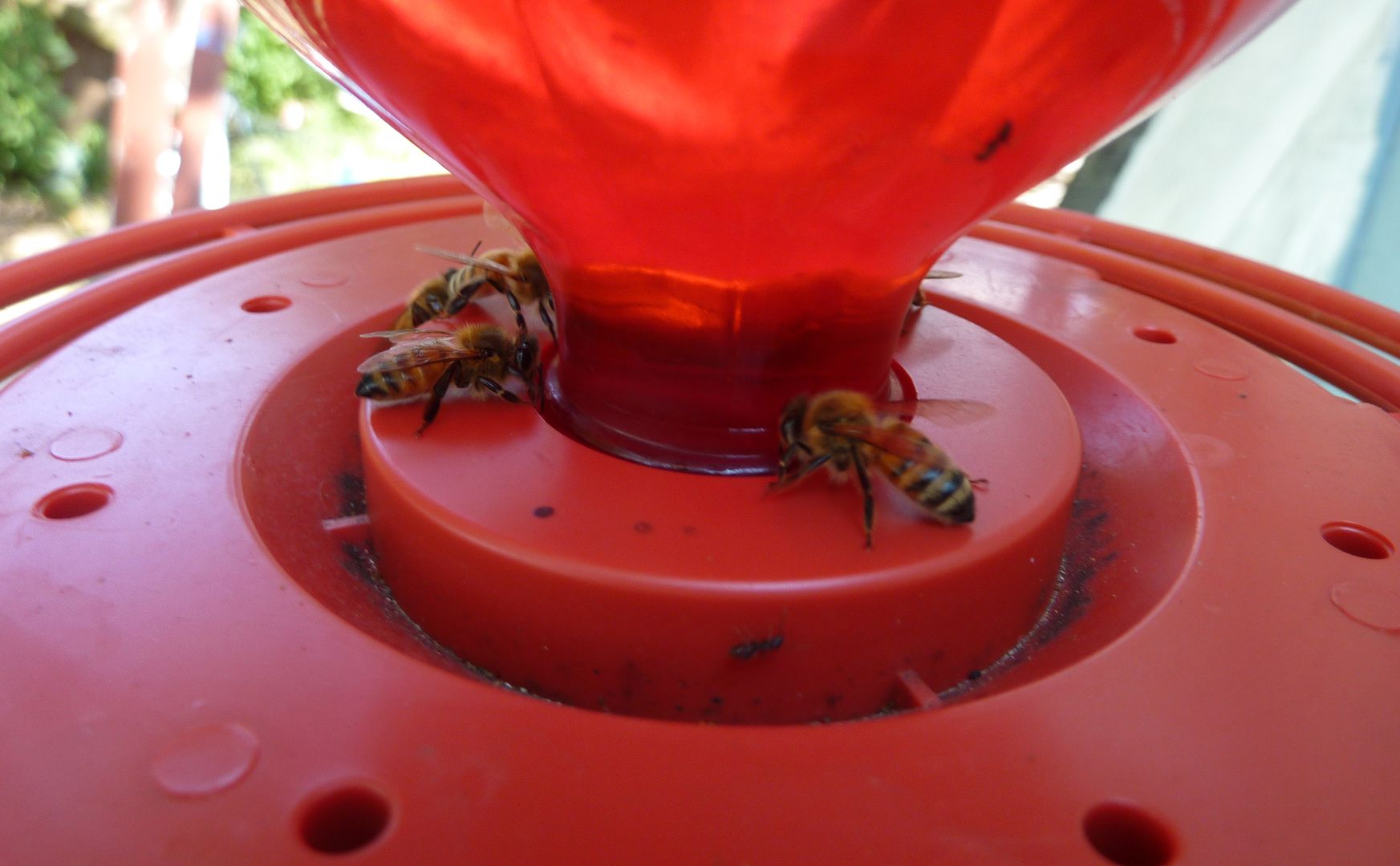 |
| Designed With Guards |
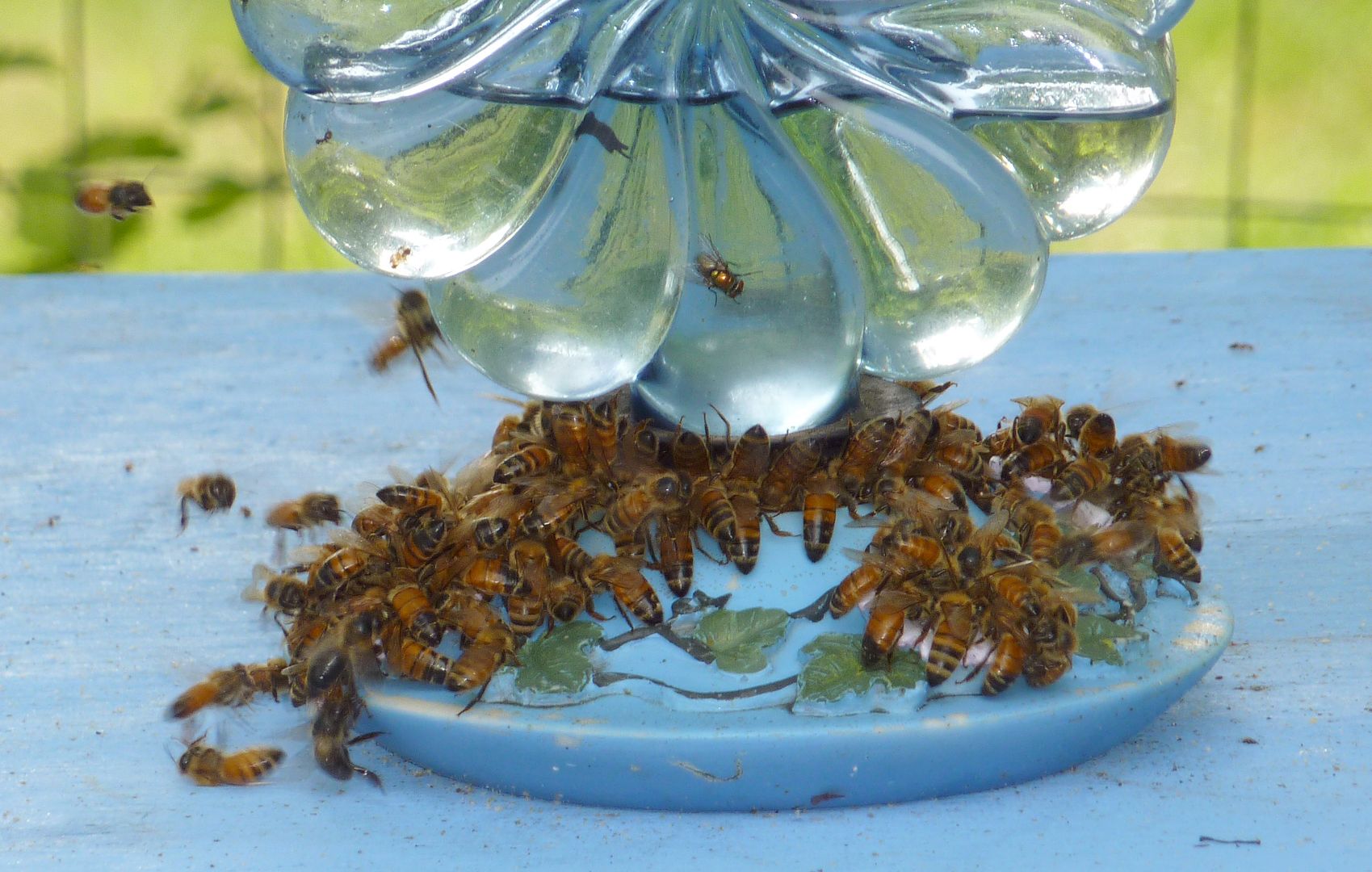 |
| Designed Without Guards |
Even with a fair amount of the foragers working none flower sources for food, the majority of the hives foragers are still out collecting food from these places. Public feeding of bees should be discouraged, especially later in the year when Yellow Jackets and Bald Faced Hornet populations start to peak. Instead we should be planting more flowering plants that the bees enjoy.
Honeybee hives are perennial, maintain populations of 20,000 to 80,000 bees year round. That means they need to forage all year long. An issue faced by most species of bee is the fact that flowers vary in size and color from plant to plant.
The flowers of an apple tree are about as simple as they come.
Trying to figure out how a passionflower works though can be somewhat perplexing.
The tube shaped flowers of a honeysuckle would be impossible for any bee to pollinate. Honeybees even struggle pollinating blueberries because the flowers are more bell-like and they don't have enough access to the pollen within. In both cases there are carpenter bees that come along and cut holes in the flowers but this results in the honeybees stealing the nectar and not pollinating anything.
Now with so much flower diversity going on, and the need for a constant food source, evolution has shaped the honeybee into an all around generalist pollinator. They tend to work best on simple flowers. You will occasionally find them working Bee Balm, or Monarda, but both of these require the bee to pry open the flower to get at the nectar and that's a task more suited for a Bumblebee. Stick with flowers in the Composite/Aster, Rose, and Mint Family for the best results.
But now we come to an environmental issue. Nonnative plants don't fit into the environment as well as their native counterparts. Fewer insects eat their leaves, and in places where nonnatives dominate that can be a major part of the food chain missing. Honeybees are notorious pollinators of Japanese Knotweed, Purple Loosestrife, Popcorn Trees, Catmint, Vitex, Bradford Pears, and dozens of other imported plants who's status varies from invasive to on watch lists from state to state. It's likely because honeybees evolved with these plants from Asia, Africa, and Europe that they are actually better at pollinating them than our native bees. As none of these are food crops though beekeepers shouldn't view the incoming nectar as a real benefit. As far as the environment is concerned, you might as well have fed them sugar water.
Don't Waste Their Time
Honeybees are a victim of their own success.
I pulled 64 jars of honey out of 2 hives one year, with the majority of it coming from one of the two. To put this in perspective, the average bumblebee hive stores enough honey to last 7 to 12 days. Where as the larger of the two honeybee hives had filled up more than half the hive with food.
At the heart of this industry is a queen bee who lays 2000 eggs on a good day. Every 21 days afterward another 2000 worker bees are born. 12 days after birth they join the foraging labor in an effort to sustain the hive. Those that find rich and abundant sources of nectar will return to the hive, and preform a waggle dance, an elegant display of trigonometry that conveys to the fellow bees where the food is. The effect tends to snowball as abundant food sources are locked onto. Whole patches of perfectly good flowers can be overlooked all because they weren't best of show.
A single plant of one species in a mixed field of other species won't get the same attention as an entire field of just that one plant species. This is what makes honeybees great for pollinating farm crops. The problem with only pollinating farm crops though is it isn't sustainable for the hive to only work one plant. Commercial Beekeepers have to constantly move their hives around, deal with pesticides, and god forbid the occasional car accident. If there aren't nectar sources or sugars to be exploited then it's a dead zone of activity for the bees. The answer to this problem is meeting somewhere in the middle. If we take that same field and fill it with an abundance of plant species that collectively flower all year long, while also grouping similar plants together, then we have a year round food source in a way for the bees.
Here a farmer is growing mustard (not native). For the few weeks in spring that this plant flowers honeybees will love it, but once this crop stops blooming they'll be far more interested in what's going on in the forest behind his fields. As most trees don't flower in the summer time their foraging will be limited.
This isn't just for farmers either. To the left here is a lawn that's doing nothing. I'm sure there are some weeds that flower but overall this is a year long dead zone. To the right however is a shallow wetland area that's too dangerous to mow and thus allowed to grow on the wild side. The trees there are willows which offer nectar in the late winter, early spring time. They're also a host plant for the Viceroy Butterfly, which is a mimic of the Monarch Butterfly.
Native plants don't have to look messy at all. Go ahead and incorporate them right into the garden, even if they're with nonnatives.
If you have a forest edge on your property then go ahead and separate it with a garden area. This is a perfect location for fruit trees, herbs and perennials. It's fine to not be 100% native but these other plants shouldn't just be there for looks. Nonnative plants should be a food crop or otherwise not invasive.
As previously mentioned, not all flowers are made equal. Some plants require a greater number in order to start getting bee attention. Pictured above is a honeybee on a Black Eyed Susan, Rudbeckia sp. This is a rare sight in my experience. They're an easy biannual plant to grow from seed, offer great color, but are not a hit with the honeybees unless there are a lot of them. Milkweed, Asclepias sp., are far more prized by honeybees and take up about the same amount of space.
For a more in depth look at the importances of native plants consider reading "Bringing Nature Home: How You Can Sustain Wildlife with Native Plants, Updated and Expanded"
The Plant List
Honeybee hives spread by division and it's not surprising that this most often happens in the spring time when most trees flower. If you have a forest around you or live in a fairly wooded community then you don't need to plant a whole lot for the spring time. A single tree in bloom can get all the attention than whole slues of wildflowers growing beneath them. Many of these wildflower ephemerals get pollinated by flies, beetles, or native bees which are less picky about where their food comes from so long as they can work the flower. Towards the end of spring and start of summer the tables turn as most trees start to produce fruit or seed. Sun loving wildflowers take center stage from then on. However, during the transition from spring to summer there is a notable drought of nectar sources that I'm at a loss to fill in adequately at this time.
So let's begin.
Most Willows, Salix sp. are wind pollinated, however bees never pass up on a free meal especially when the plant is offering it so willingly. (Over the summer time Corn is an excellent source of pollen for the same reason!) Even with this source of food though it's best to feed your hive sugar water just to help them over the hump before everything gets going. Honeybees will forage whenever it's 45F or higher outside and those days can be come and go early on. Maples, Oaks, Hazelnut, Most Fruit Trees, Redbuds, Dogwoods, Birch, Poplar, Tulip Trees, Magnolias (native and non), Nut Trees and just about everything else in the forest are quick to start flowering afterward.
Anyone interested in giving a home to a native tree that's extinct in the wild should consider the Franklinia, Franklinia alatamaha. Originally this plant was only native to Georgia, it's actually been found to be much more able to grow up north without much problem. They bloom over the summer time with great big Magnolia-like flowers that look very inviting and bee friendly in my opinion. I would sooner plant one of these over a Crape Myrtle, or Seven Son Tree, simple because it's at least native to North America, while the other two are imports from Asia.
Jacob’s Ladder, Polemonium caeruleum, is a very versatile native perennial that flowers in the spring and can handle full sun to full shade, dry to fairly wet, and grows in most soil types. A reliable source tells me Honeybees visit the flowers but so far I haven't seen anything bothering with them, but this is their first year blooming in the garden so we'll see what happens.
Mountain Mint, Pycnanthemum sp. Generally anything in the Mint Family is treasured by bees and this plant is no exception. Mints can be a little aggressive though and sure enough this plant can send out root suckers 3' away from the original plant. Weeding them out so far has been as simple as pulling them so it's easy to control and the leaves smell wonderful. It's quick to start growing each spring and tends to flower around the late spring early summer transition.
Sumac Trees and Black Locust, Robinia pseudoacacia both flower around this transition time. Where I am in NJ Locust trees are a major source of nectar. Their blooming doesn't always line up with this transition time perfectly, so some years they're ahead while others they're behind.
Later in the summer one of the latest Sumacs to flower is the Winged sumac, Rhus copallinum. And it steals all the attention. It's actually a shrub that is commonly seen along forest edges and highways. The flower clumps are green though so it's often overlooked. The tiny flower shape allows for all sorts of pollinators to gain access to the nectar, however the flow seems to die down by 4:00pm each day. I've also noticed this plant doesn't flower well in droughts, and the flower buds are easy to fall off the plant during harsh storms. Sadly this wonderful nectar source is hit or miss each year.
I'd recommend it as a landscaping shrub if it weren't for the fact it sends up root suckers. Whenever you find them in the wild they're always in clusters along a forest edge, making their own grove. Some specimens can reach 30' tall but this isn't that common.
Tickseed, Coreopsis. There are loads of easy to grow species of Coreopsis out there that come in all sizes. The tallest one I know of is C. tripteris, which gets to be 7' tall! The genus is otherwise mostly small roadside plants. While I wouldn't say they're lusted after by honeybees, they're a major group of plants for some our native bees. Many species will aggressively divide by rhizomes underground or will more timidly spread around by seed.
Coneflowers, Echinacea sp. These are a tried and true wildflower. In mass they're a food source to Goldfinches and to bees they're a fair nectar and pollen source in their own right. Plants that have been started by seed tend to be great at seeding themselves around. Cultivars and nursery grown plants don't seem to be as prolific. Many cultivars don't seem to make as much pollen as they should either. Another failing is Aster Yellows Disease. This infection causes the plant to make green monstrosities instead of real flowers, and sadly the only cure is to remove the entire plant. The disease is spread by aphids, and the common dandelion is a carrier. In the interest of flowers, effected plants should be weeded out immediately and their foliage put right in the trash.
Anise Hyssop, Agastache foeniculum. If ever there were a universally accepted bee plant in the world, this would be it. New Jersey has about 2,000 beekeepers in the state and I'll bet money that most of them know about this plant. They look great in the garden, and most days bees will be working the flowers from sunup to sundown. You couldn't ask for more of a bee plant.
Though technically I think they're a mint plant, they are not aggressive spreading at all which is surprising from a plant that gets this much attention!
Black Eyed Susan, Rudbeckia sp. This group barely made my list. I have seen great big clumps of this plant with nothing working them. But then I'll occasionally see a bee working one or two flowers, that might not even on a plant with the largest gathering of flowers. I feel like this was a poor nectar plant to begin with that's been selectively bread somewhat so it makes even less pollen and nectar, or in some cases more. Whatever the case, this plant sometimes works and sometimes doesn't. Skip it in favor of other plants on this list if you're on the fence about it. At the same time though I'll say you could certainly plant worse, and they're cheaply started by seed.
Spiderwort, Tradescantia sp. This is a new plant for me. I think of it as an ornamental onion with some pretty little flowers that only open in the morning and are quick to vanish by mid afternoon. Honeybees pay good attention to it even when there are few of them of them open (6 or less). So that's got my attention and I'd be curious to see what they do when given a field to work with. Plants have a nice grass-like appearance which can be an alternative to meadow grasses for people looking for a meadow that leans towards wildflowers.
Sunflower, Helianthus annuus. Sunflower seeds are a lesson in how amazing an annual can be. When one thinks of a tiny seed smaller than their fingernail few people realize that in just a few months it can be a massive tree-like plant with more than 50 flower heads blooming all at once. Sadly few seed pack grown varieties yield the aggressive potency found in wild strains. The genetics is certainly there if one saves seeds each year. Often annual sunflowers that come back the following year seem to grow much taller and more vigorous than their parents did. Honeybees mostly use these just for pollen and often one finds them working the flowers almost on accident. There was a study once that found Honeybees would only work the flowers to one variety after seeing a bumblebee on it. Native bees are far more common visitors of these but the attraction of sunflowers shouldn't be avoided. Pollen is important for a honeybee hive, and Goldfinches are regular visitors of the flowers. I try to plant $5 worth of seeds every year.
 |
| Heliopsis helianthoides 'Summer Nights' |
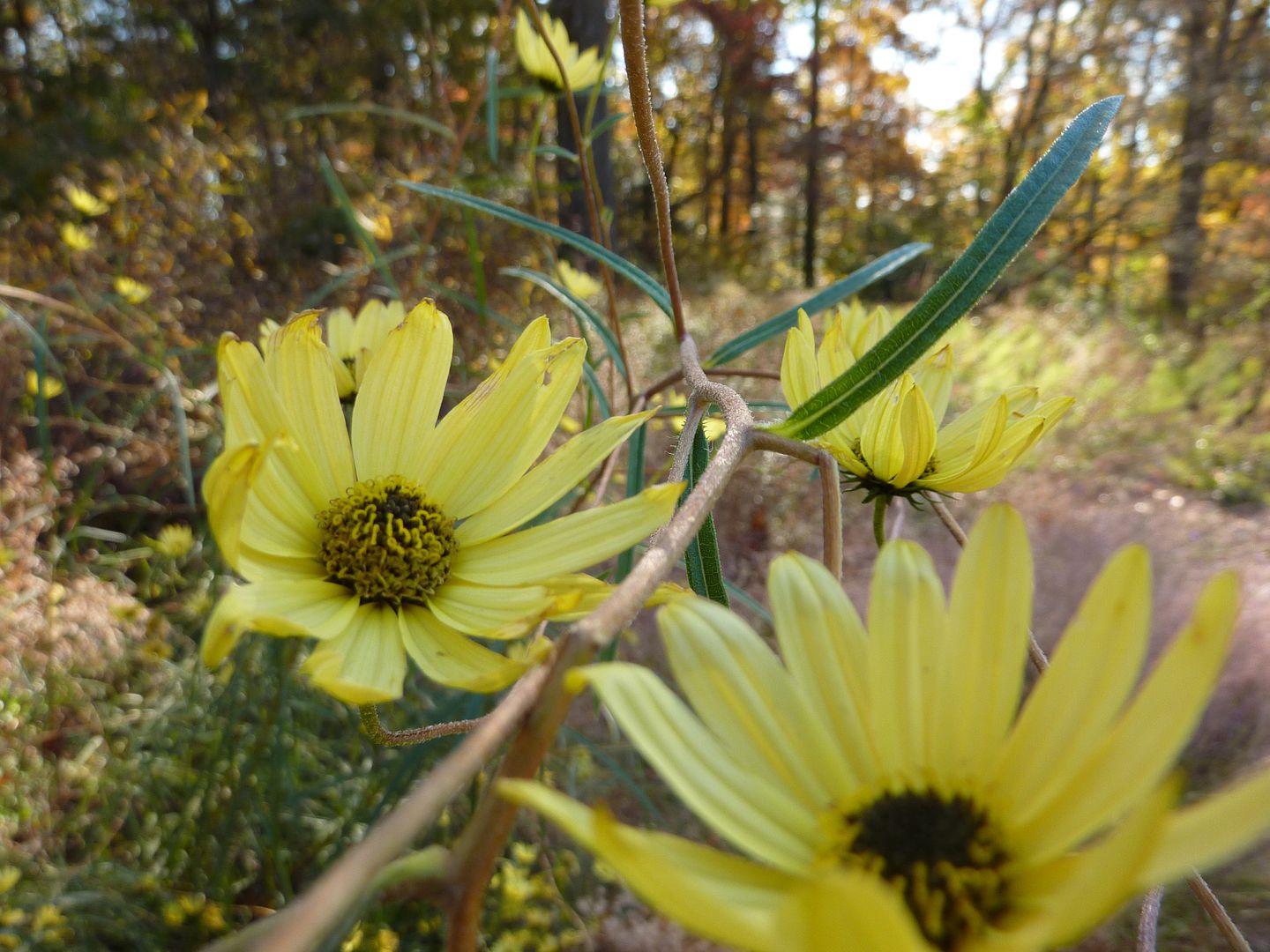 |
| Helianthus angustifolius, Narrow-Leaf Sunflower |
It's worth mentioning that there are also perennial sunflowers, however I've noticed most of them bloom in late summer, early autumn when Asters and Goldenrods seem to take center stage. Of ~50 species in the U.S. I'm sure one of them does a great job at getting honeybee attention, I just haven't found it yet.
Buttonbush, Cephalanthus occidentalis. Think of this plant as a native Butterfly Bush. This shrub blooms in the summer with lots of tiny balls of white flowers. Sadly they are short lived with each cluster lasting maybe 4 days but this is done in succession on the plant. As one closes, another one seems to open. Even with few flowers open at a time though honeybees still stop to work them. I've been told it's a rare sight to see one of these plants in bloom that didn't have a swallowtail on it too. I don't think they love it that much but I do find swallowtails flocking to them. As with the Butterfly Bush, this plant wants to turn into a 10' by 10' shrub but does it at a slow and steady pace. They love getting their feet wet too. In the wild plants don't mind growing in up to 4' of water.
Culver’s Root, Veronicastrum virginicum. I have this plant on order but so far I like what I see on youtube.
Milkweeds, Asclepias sp. This host plant to the Monarch Butterfly is an excellent nectar plant, and many species bloom from late spring to the end of summer. Some beekeepers don't like it though because the anther sacks get stuck to the bee's legs and it's not uncommon to find bees dangling helplessly under flowers. This actually isn't what kills them though so beekeepers shouldn't be afraid to plant this wonderful wildflower. What's happening is assassin bugs take advantage of the situation and use it as their time to strike. Assassin bugs can be found on any plant though and regularly kill honeybees on Russian Sage, Anise Hyssop, and I'm sure lots of others. The difference here is when killed on Milkweed the bee corps is still hanging from the plant.
Stokes Aster, Stokesia laevis. Honeybees will work this plant despite the lack of flowers in comparison to other plants. Sadly it's not one that's ever done well in my garden. I recall it getting more attention than the Coneflowers next to it though.
Blanket Flower, Gaillardia grandiflora. This is a nice wildflower that's great for filling out a lot of space. When planted in the hot, sunny, dry places that it likes the plants tend to fan out like a mum, blooming in the summertime and cover itself in flowers. Cultivars come in solid yellow (as seen above), true species with a red ring in the middle, and solid red. Honeybees don't actually care if the flower is red in this case but for those who believe it makes a difference, then go ahead and stick with solid yellow forms.
Blazing Star, Liatris sp. This is among the easiest of native wildflowers to find in mass production. They're cheap too at around $7 for 12 to 50 plants. The roots are small potato-like corms that can be planted in mass all in the same hole, but spread out so as not to overlap too much. Each plant produces a single stem covered in thin grass-like leaves with the flower column at the top. Oddly enough flowers at the top open first and they work their way down on a last grown first to flower basis. Goldfinches will eat the seeds but it's not as commonly seen as on sunflowers. Plants will slowly divide underground but because this is done at an upward angle rodents are quick to eat the new plants. In the wild, Liatris species seem to do best around dense grasses where these new divisions are better protected. In the garden a thin layer of mulch can help.
Varieties that flower later in the summer tend to be a big hit with Monarch Butterflies. Meadow Liatris, Liatris ligulistylis, is one such plant that blooms in late summer. Honeybees don't bother with it as much as other species though but the Monarchs sure cling to it.
Cup Plant, Silphium perfoliatum. This is a great native plant that gets fairly tall, and who's flowers get lots of attention. They like growing where it's wet but handle drought fine on their own.  I feel like this plant gets more environmental praise than it deserves. The leaves form little cups all along the stem and fill with a rather pitiful amount of water. While I have seen bees and birds drinking at these it doesn't happen anywhere near as often as you'd think. Reports of frogs laying eggs inside the leaves I'll believe when I see it in person, because the wells don't fill for much longer than two days. In truth these small pools of water are a defense against ants steal nectar from the flowers above. Other members of the Silphium genus don't have these cups but are equally good at attracting pollinators.
I feel like this plant gets more environmental praise than it deserves. The leaves form little cups all along the stem and fill with a rather pitiful amount of water. While I have seen bees and birds drinking at these it doesn't happen anywhere near as often as you'd think. Reports of frogs laying eggs inside the leaves I'll believe when I see it in person, because the wells don't fill for much longer than two days. In truth these small pools of water are a defense against ants steal nectar from the flowers above. Other members of the Silphium genus don't have these cups but are equally good at attracting pollinators.St. John's Wort, Hypericum sp. This plant blooms right in the middle of summertime when bees need it most. Tragically blooms don't seem to last much longer than 5 days. Species of this plant come in both shrub and herbaceous perennial form. Some are longer blooming than others but I haven't studied the genus in depth that much yet. Pictured above is an unidentified shrub form that for all I know isn't even native, but that's not going to stop me from growing it, as long as it's not a weed. I can live with a 50/50 chance of native or not.
NOTE: Hypericum perforatum is an invasive nonnative plant. It's a herbaceous perennial form that spreads like the plague and is toxic to livestock.
Summersweet, Clethra alnifolia. This plant is also called Sailor's Delight because its fragrance could be smelled far out at sea. This is an excellent summer blooming shrub. It's a little late to leaf out in the spring but that's about it's only fault. They are shade tolerant but will grow happily in full sun too. They normally grow along streams and have a wonderful scent. The strength of this delightful fragrance seems to vary depending on various conditions. One plant I could smell from several yards away and was absolutely mobbed with what had to be the highest diversity of pollinators I'd ever seen in one place. To date though I've never seen any other plants getting that much attention.
Joe Pye Weed, Eutrochium sp. formerly Eupatorium. As a public service announcement, the genus Eupatorium has been split into 3 genera now. I'm no botanist but here's how I think they've divided the genus.
Eupatorium is now comprised of all the (mostly) white flowering Boneset plants. These gets lots of pollinators but I've noticed odd types of wasps favoring them mostly.
Conoclinium is now comprised of all the blue/indigo flowering ... uhh Blue Mist Flowers. Conoclinium coelestinum is the only species I know of in this group. I've seen pictures of Monarch butterflies on them, but rarely do I see bees or anything else for that matter.
Eutrochium is where it's at! These are the pink/purple/magenta flowering Joe Pye Weeds. These are massive perennials that form large clumps with canes reaching up to 12' tall, though stopping between 6' and 8' is more common. There are also dwarf versions that only reach 4' high. Butterflies love them, bees love them, I love them! When the afternoon shade finally hits the flowers a very medicinal scent starts to emanate from the plant. When it comes down to money vs. nectar production this is one of the best bangs for your buck. They will take up a lot of space when they get big, and on some years they will flop over, but they're worth it.
Ironweed, Vernonia sp. This is another one of those plants that I read and people tell me that it attracts a lot of butterflies and bees. I believe them on the butterflies but the bees... so far not so much. This is another tall perennial like the Joe Pye Weed, but tends to have a more up right habit.
Goldenrod, Solidago sp. Even the aggressive Canadian Goldenrod can be controlled in a garden by simply pulling up the canes early on in the year. They pull right out of the ground and are otherwise shallow rooted enough that a shovel makes quick work of them. Pulling out of the ground is easier to do early in the year when it's still cold out and canes are only a few inches tall. As their smaller feeder roots swarm out into the soil they become far more difficult to remove.
Solidago rugosa tends to be more timid spreading but still pushes up easily controlled root suckers. The cultivar 'Fireworks' is a good one to go for. As the name suggests they flower out on what look like shooting firework explosions.
Solidago spacelata 'Golden Fleece' is a low growing ground cover that gets some attention too.
Asters, Symphyotrichum genus. As another public service announcement. Asters in North America are called Asters in common name only. (They are NOT MUMS and have nothing to do with them! Chrysanthemums are a very similar looking genus of plant imported from Asia.) Asters in North America has been broken up into 7 genera that are somewhat easily distinguish by the flowers. Symphyotrichum is the one you want. Here are a few suggestions.
New England Aster, Symphyotrichum novae-angliae. Video 1, Video 2. Their only failing is that they grow too tall and sometimes fall over. I'm told you can trim them short toward the end of June, (really it's more like the end of July I think!) and they'll turn Mum-like with a neat dome of flowers. I've always been afraid to experiment with this though and have never done it.
New York Aster, Symphyotrichum novi-belgii, tends to be lower growing. However, I've found it to be not as popular as New England Aster. It's a close race though for attention and both plants are worth growing.
Aromatic Aster, Symphyotrichum oblongifolius, is the most well behaved of them all. They have a natural dome forming habit and quickly fill out spaces around them. They have a very minor fragrance to them but it's nothing worth mentioning in my opinion. It's there if you look for it though.
Georgia Aster, Symphyotrichum georgianum, I like to think of as a messier form of Aromatic Aster. I think this is one of the latest flowering Asters in the US as it blooms after the New England Asters have finished.You can even see in my photo leaves from nearby trees have gotten caught in the foliage.
Labels:
Bees,
environment,
flowers,
Honeybees,
List,
native,
Trees,
Wildflowers
Subscribe to:
Posts (Atom)

